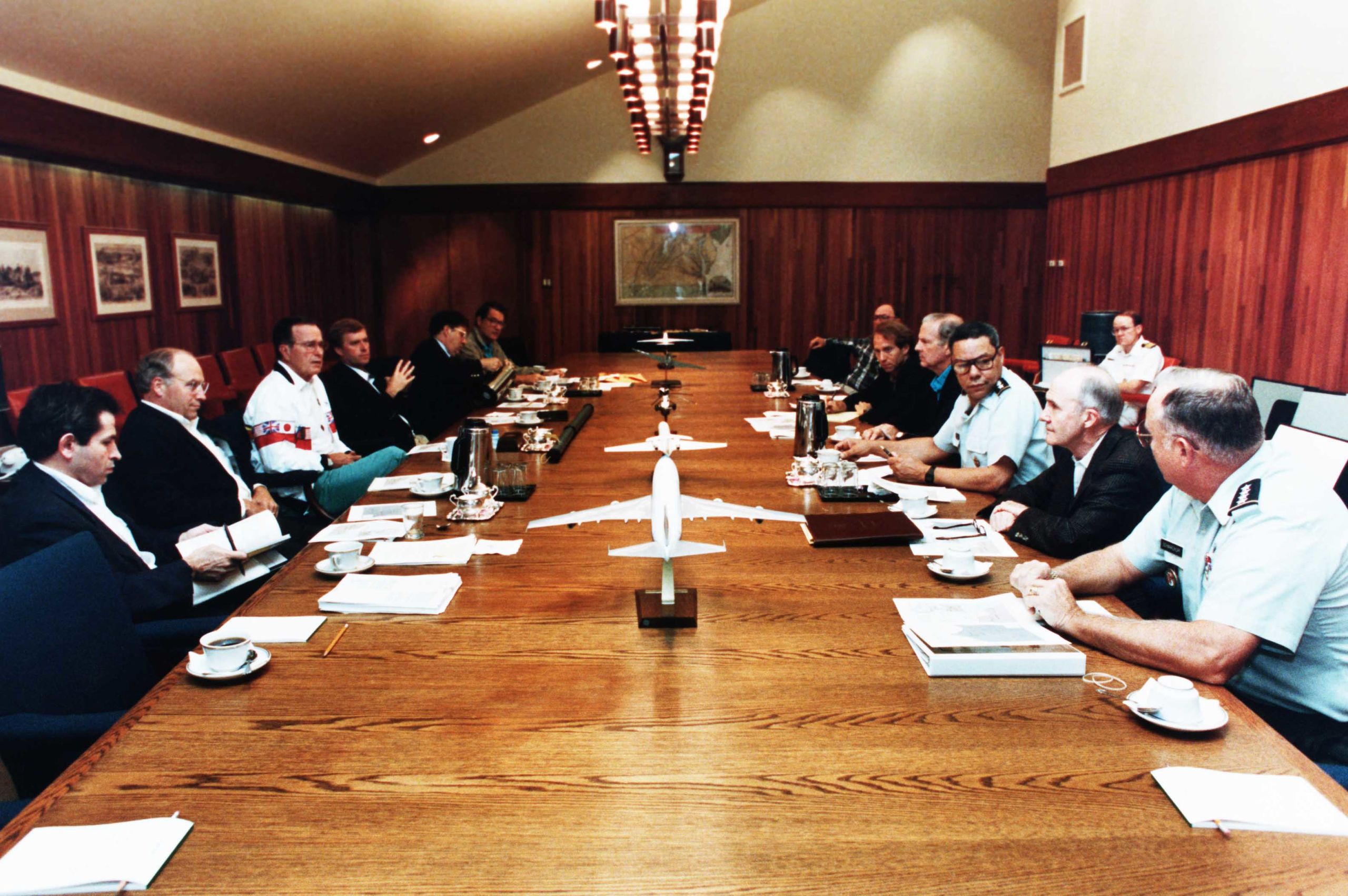Desert Storm:
30 years on
The end of the Gulf War on Feb. 28, 1991 saw the eviction of Iraq from Kuwait but paved the way for decades of conflict

Almost no one saw the First Gulf War coming, but almost everyone with a television set saw it unfolding, bomb by bomb, shot by shot, night by night on the evening news.
This war, an epic clash of more than a million soldiers and thousands of aircraft, missiles, warships, tanks and artillery, had the grim distinction of being the first to be broadcast live around the world.
For Saudis, however, the war was not only fought on their TV screens but was also experienced firsthand. The Kingdom’s soldiers and airmen were on the front line, dozens of Scud missiles fell on Riyadh and other cities and, at one point, Iraqi troops invaded Saudi Arabian territory.
Perhaps most traumatic for Saudi Arabia and the other Gulf states threatened by Saddam Hussein’s Iraq was the sundering of the brotherly bonds that, until that moment, had meant that the prospect of one Arab state turning on another was unthinkable.
Perhaps most traumatic for Saudi Arabia and the other Gulf states threatened by Saddam Hussein’s Iraq was the sundering of the brotherly bonds that, until that moment, had meant that the prospect of one Arab state turning on another was unthinkable.
It began on Aug. 2, 1990, when Saddam invaded and occupied his small southern neighbor, Kuwait. It ended 30 years ago, on Feb. 28, 1991, after a 42-day aerial bombardment followed by a ground assault by a US-led coalition that lasted just 100 hours.
As wars go, it was a short one — Saddam’s aggression was met by an overwhelming display of force by a US-led coalition of nations, including the Gulf states, outraged by the dictator’s murderous adventurism.
It was certainly shorter than the Iraq-Iran War, a brutal eight-year conflict that finally came to an end on Aug. 20, 1988. By some estimates, as many as 500,000 on both sides had died in the fighting, and Iraq, formerly an oil-rich country, had been transformed into a nation on its financial knees.
In 1988, not for a moment did any rational observer foresee what came next. Another war would surely be the very last thing that Saddam would contemplate after the carnage of the past eight years, and yet he invaded his small southern neighbor, Kuwait, triggering the First Gulf War and the calamitous chain of events that would follow it.
Having failed in his declared ambition to annex Iran’s oil-rich Khuzestan Province, the dictator now intended to make Kuwait the 19th province of Iraq.
It was not the first time in living memory that an Iraqi leader had tried to annex the small country. In 1961, one week after Kuwait gained its independence after 62 years as a British protectorate, Iraq’s President Abd Al-Karim Qasim, who had overthrown the Iraqi monarchy in 1958, threatened to invade. Qasim argued that as Kuwait had been part of the Ottoman vilayet of Basra, which was now in modern-day Iraq, Kuwait was “an integral part” of Iraq. He was dissuaded only when Britain rapidly dispatched 3,000 troops to protect it.
But Saddam’s motivation for launching such a risky land grab was rooted less in historical precedent than in bitterness, desperation and self-delusion. Humiliated in the eyes of many Iraqis by his failure to defeat Iran, and with the impoverished Iraqi state unable to contemplate flooding an already near-non-existent job market with hundreds of thousands of demobilized soldiers, Saddam sought to shift the blame for his country’s precarious condition onto the Arab nations that had supported Iraq during its war with Iran — Kuwait and Saudi Arabia.
Even in the face of such an extraordinary betrayal, the Gulf states worked to find a peaceful solution to the crisis, but Saddam was hellbent on bloodletting. It was an outrageous gambit, certain to fail, and fail it did. But the end of the First Gulf War was just the beginning of decades of catastrophe — for Iraq and the entire region.
Precursors to war
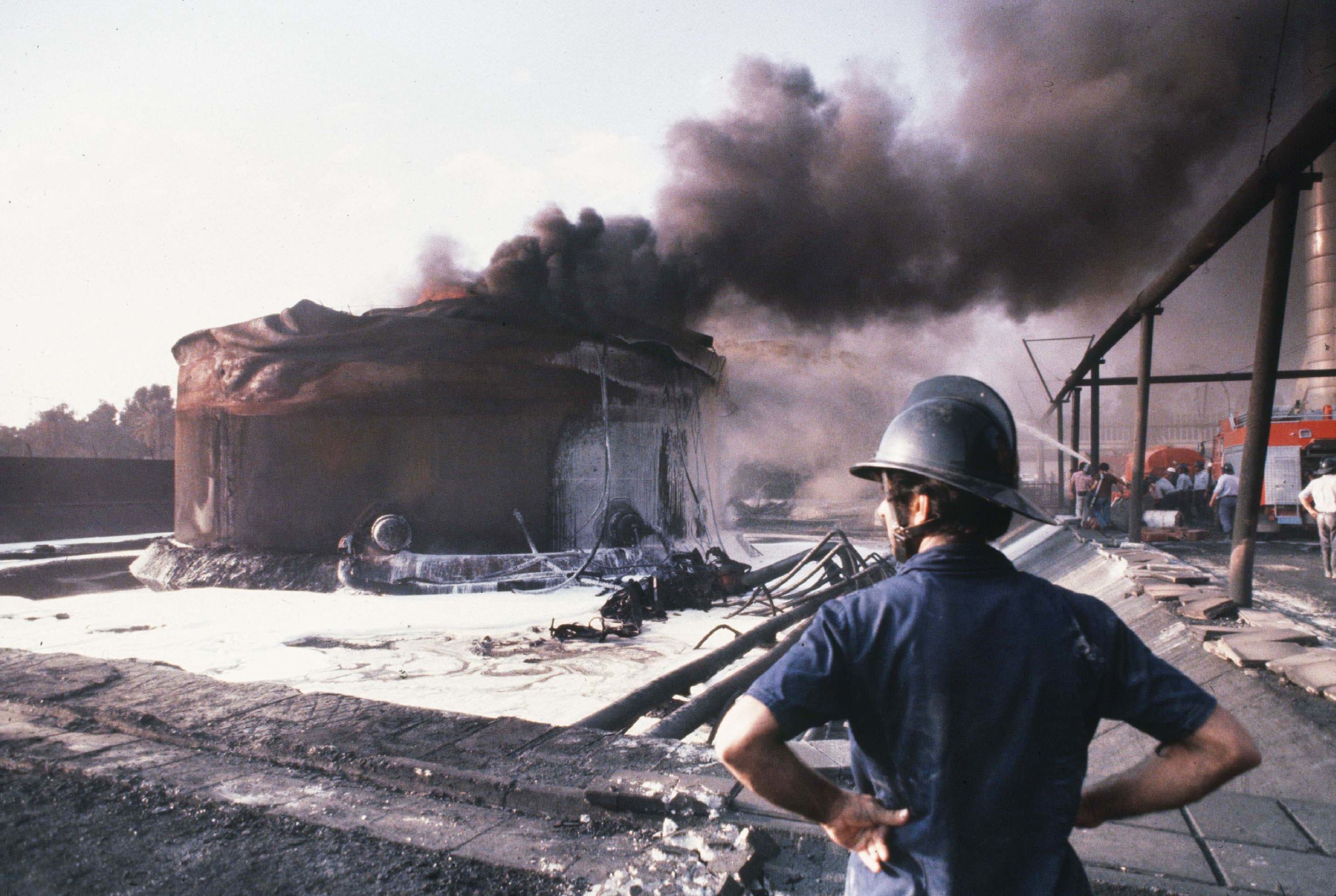
When Saddam Hussein seized power in 1979, Iraq was debt-free, sitting on foreign-exchange reserves of $35 billion and enjoying oil revenues that in 1980 alone earned the country $26 billion.
That all changed on Sept. 22, 1980, when the dictator invaded Iran, triggering eight years of war that devastated the Iraqi economy.
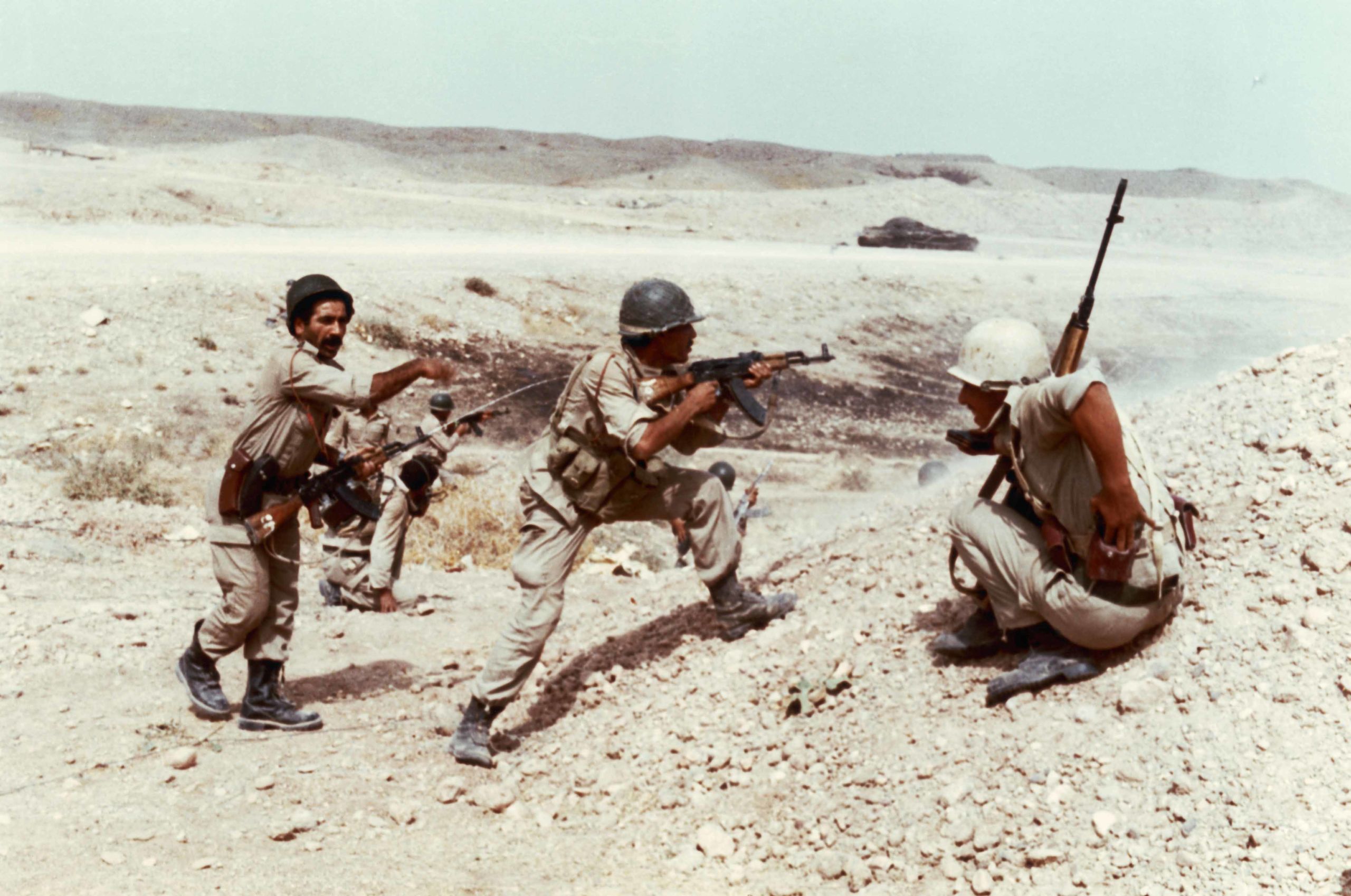
Iraqi soldiers clash with Iranian troops along the Iran-Iraq border in July 1984, midway through the eight-year war between the two countries. (Getty Images)
As the fighting dragged on, oil revenues dried up and Iraq burned through its reserves. Shunned by international lenders, Saddam went cap in hand for loans to sympathetic Gulf states. By the end of the war, Iraq was in debt to its neighbors to the tune of $40 billion.
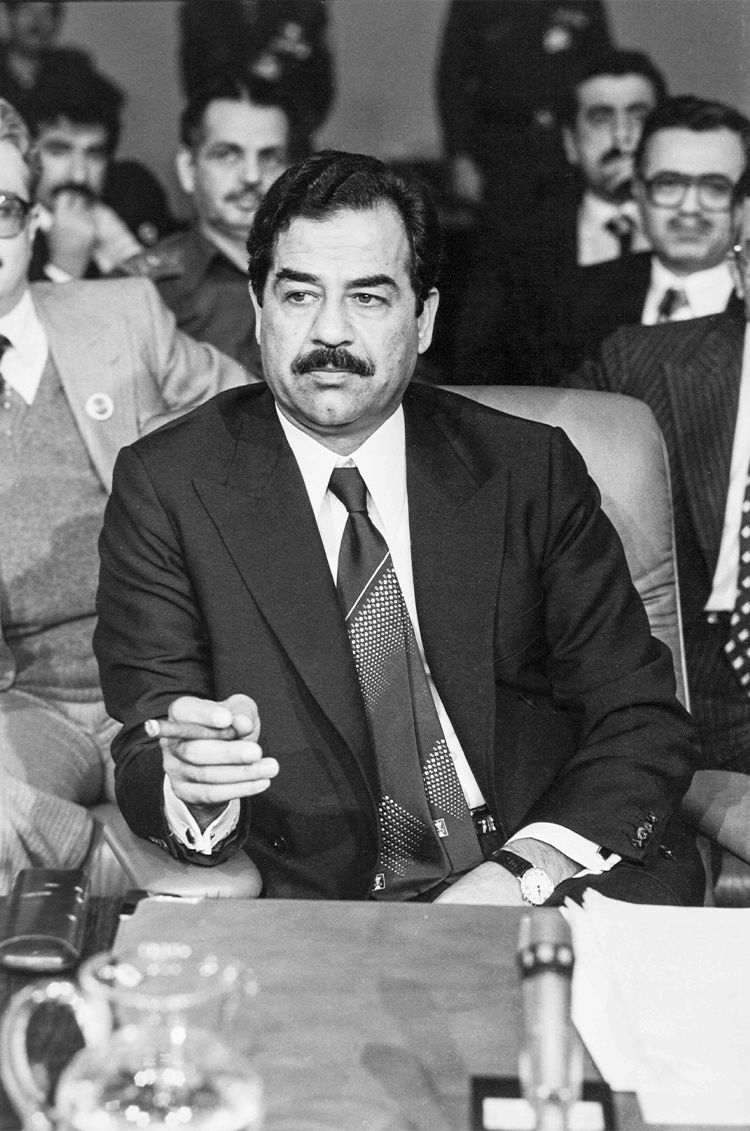
Iraqi President Saddam Hussein during an Arab summit in Jordan in November 1980. (Getty Images)
Before the war with Iran, among the OPEC states the scale of Iraq’s oil exports had been second only to Saudi Arabia’s. In 1979, Iraq exported 3.3 million barrels per day, accounting for 11.4 percent of OPEC’s total exports and earning the country $21.4 billion.
By 1983, however, barely three years into the war, its oil exports had fallen to 0.74 million barrels per day, producing revenue of only $7 billion.
“Ironically, as the war continued to be fought on Iraqi soil and oil revenue continued to decline, Iraq’s dependence on this source of income intensified since this dwindling income had to pay for essential military and non-military imports, to service foreign debt, and to serve as the basis for fresh borrowing,” wrote the renowned Iraq-born economist Abbas Al-Nasrawi in his 1994 book “The Economy of Iraq: Oil, Wars, Destruction of Development and Prospects, 1950-2010.”
“An important consequence of this changing picture of Iraqi oil was the increasing dependence of the Iraqi regime on the financial support its neighbors, especially Saudi Arabia and Kuwait, were willing to provide.”
Kuwait and Saudi Arabia agreed to produce and sell some 0.3 million barrels per day of their own oil on behalf of Iraq, while the Kingdom took steps to shore up Iraq’s creditworthiness in the international financial markets and allowed Iraq to build pipelines across Saudi territory.
Crucially, Kuwait and Saudi Arabia also agreed to a series of loans — generosity that helped to keep Iraq afloat during the war but that would ultimately backfire. Saddam turned on the two countries to which he owed his very survival, demanding that the Gulf states write off the loans that, he insisted, should be regarded as gifts from countries grateful for Iraq’s stand against Iranian expansionism.
Iraq’s penury, he added, was to be blamed not on the war but on the “glut in the oil market” created by Kuwait’s increase in oil production during the crisis, which had suppressed oil prices and prevented the recovery of Iraq’s economy.
Throughout 1990, Iraq put continuous pressure on OPEC to limit output. The simmering row boiled over on July 17, when Saddam openly threatened to take military action against Kuwait and the UAE — a threat reinforced when he massed 100,000 troops on the Kuwaiti border.
By July 25, however, a compromise was reached with OPEC that seemed to defuse the crisis. The decision by Kuwait and the UAE to reduce oil production, pushing up global prices, made front-page news around the world.
At noon that day in Baghdad, April Glaspie, the US ambassador to Iraq, was summoned by Saddam. It was, as Glaspie’s cable to Washington noted, the first time he had ever called in a US ambassador, and her report of the meeting offered a fascinating insight into the Iraqi president’s frame of mind.

Throughout the two-hour meeting, his manner was “cordial, reasonable and even warm,” but he quickly began to list his grievances, against the US, Kuwait and the UAE. Iraq, he conceded, was in serious financial difficulties. After its “victory” over Iran, which he said had “made a historic difference to the Arab world and the West,” Iraq deserved “a Marshall Plan” — a reference to the US aid program in Western Europe following the Second World War.
Instead, complained Saddam, “you want the oil price down,” and “some circles” in the US government were even gathering information on who might be his successor. The US, he said, was also encouraging “those who are damaging Iraq” — a reference to the UAE and Kuwait.
“At this point,” Glaspie reported, “Saddam spoke at length about [the] pride of Iraqis, who believe in ‘liberty or death’.” Although Iraq “knows the US government can send planes and rockets and hurt Iraq deeply,” he “asks that the US not force Iraq to the point of humiliation at which logic must be disregarded.”
The ambassador asked Saddam why he had positioned so many units of the Republican Guard on the border with Kuwait. Saddam replied, “How can we make them (Kuwait and the UAE) understand how deeply we are suffering?”
The main US takeaway from the meeting was that “Iraq wants friendship.”
The following day, The New York Times reported that “the Iraqis’ apparent success at the meeting of OPEC nations that began today came as tension in the Persian Gulf region seemed to diminish considerably, largely because of fast-paced shuttle peace talks among Iraq, Kuwait and Saudi Arabia undertaken by Egypt’s President Hosni Mubarak.
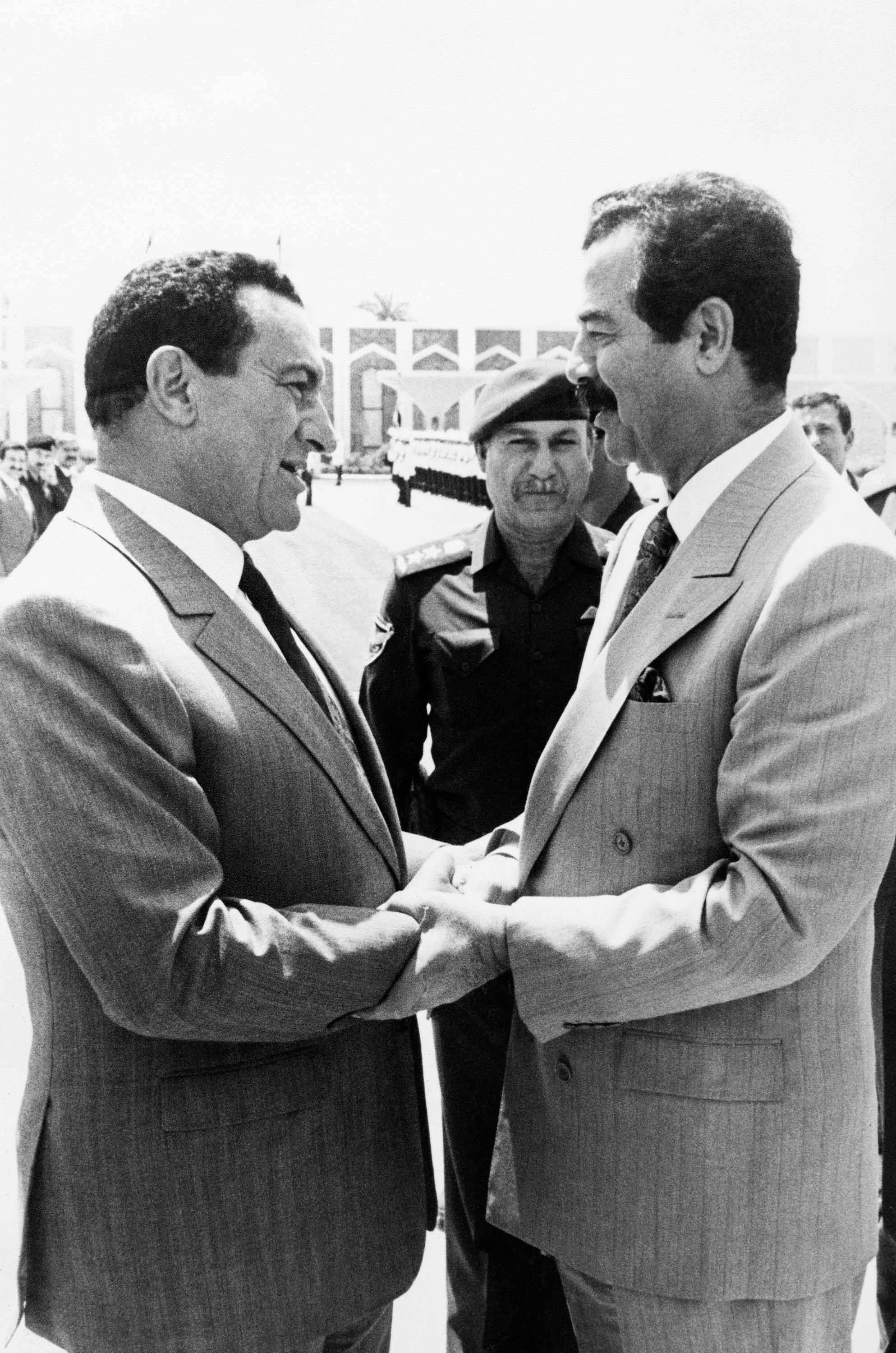
On July 24, 1990, Saddam greets his Egyptian counterpart Hosni Mubarak, who was trying to find a peaceful solution to the crisis. (AFP)
On July 24, 1990, Saddam greets his Egyptian counterpart Hosni Mubarak, who was trying to find a peaceful solution to the crisis. (AFP)
“President Mubarak said Iraq had agreed to a peaceful settlement of its differences over oil policy with Kuwait and the United Arab Emirates.” On July 28, after OPEC formally agreed to cut production — thus complying with Iraq’s desire to see oil prices raised — the oil states welcomed what Hisham M. Nazer, Saudi Arabia’s oil minister, called “a historic accord.
“I feel very confident,” he added, “it will achieve its objectives.”
Certainly, over the next few days, the threat of conflict did appear to recede. On July 31, delegations from Iraq and Kuwait flew to Jeddah for talks brokered by Mubarak and King Fahd of Saudi Arabia. The king received the delegations and, after the first day of talks, hosted a dinner for them at Al-Hamra Palace.
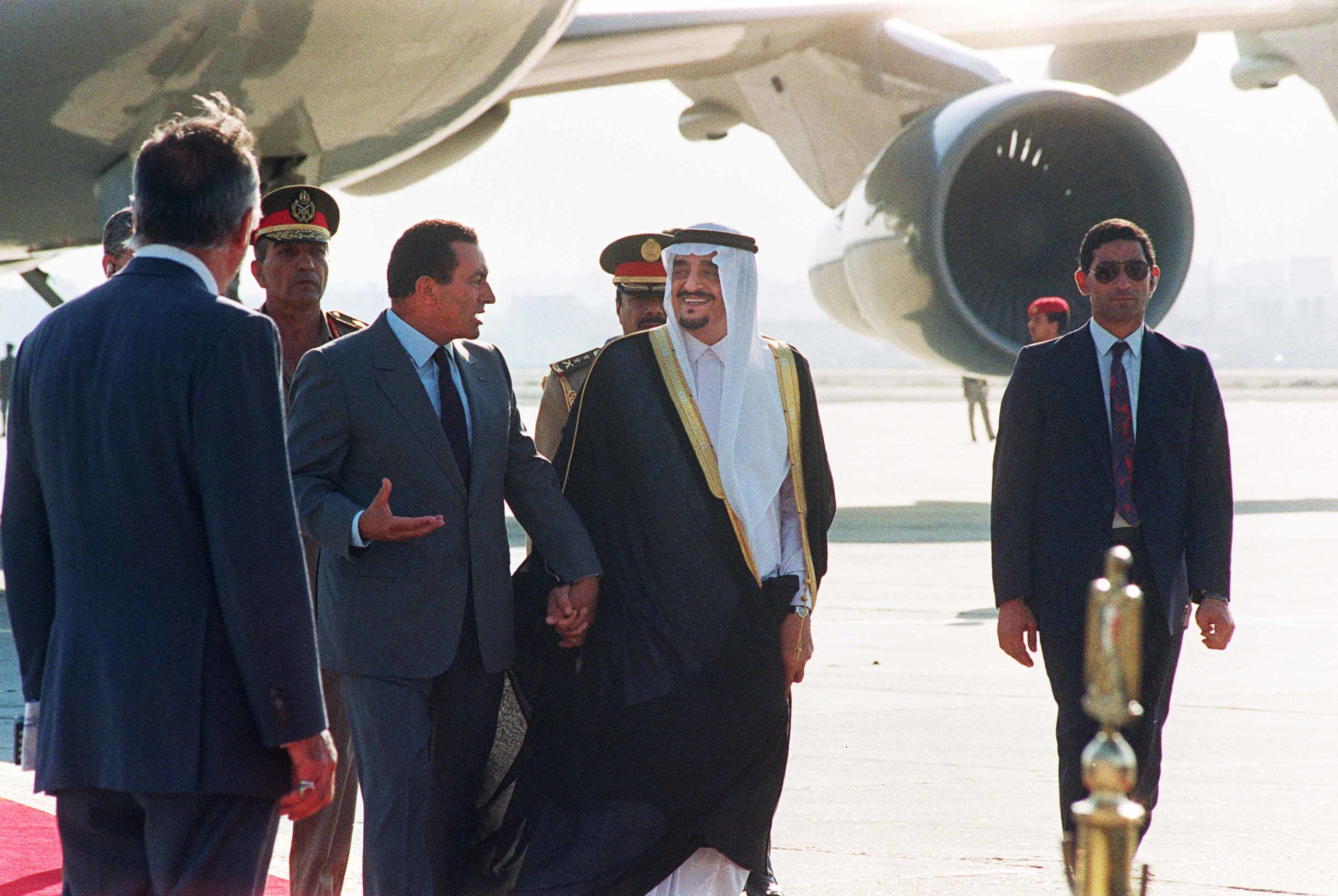
Egyptian President Hosni Mubarak greets Saudi King Fahd upon his arrival in Cairo on Aug. 9, 1990 for an emergency Arab summit to discuss Iraq's invasion of Kuwait. (AFP)
Local media reflected a general sense of optimism. The meeting, commented Saudi newspaper Al-Yaum, would “definitely lead to the achievement of the ambitions of the Arab leaders for keeping the Arab nation away from any differences that might impede the process of Arab solidarity.”
Such optimism, however, proved to be misplaced. On Aug. 1, the talks stalled. In Washington, US Assistant Secretary of State John H. Kelly summoned Iraq’s Ambassador Mohammed Sadiq Al-Mashat, warning him that the dispute “must be settled peacefully.”
The issue was critical for the US, which over the previous five years had become increasingly dependent on foreign oil. Its imports had risen from 5.1 million barrels a day in 1985 to an average of 8.3 million by April 1990, with half coming from OPEC producers.
Brent Scowcroft, President George H. W. Bush’s national security adviser, later recalled that the US saw the dispute between Iraq and the Gulf states as “a struggle over control of OPEC, a struggle basically between Saudi Arabia and the radicals, over keeping production flowing and keeping prices reasonable or trying to squeeze the industrialized world.”
In July, disturbed by Iraqi posturing and overt threats against Kuwait and the UAE, the US had dispatched two aerial-refueling aircraft and a number of warships to the Gulf for a joint exercise with UAE forces, a move intended to “bolster a friend and lay down a marker for Saddam Hussein.”
Yet even in Kuwait, at the beginning of August “an invasion was something which most people refused then to see as a possibility,” recalled Kirsty Norman, an American conservator who was working at the Kuwait National Museum in the summer of 1990.
“Saddam Hussein’s regime had postured and threatened before, and the disagreements of that summer over oil rights and prices were certainly not expected to result in war,” she wrote in an article in the journal Museum Management and Curatorship in 1997.
On Aug. 1, The New York Times reported that “despite the tensions … the prevailing view within the Bush administration has been that Iraq was trying to intimidate Kuwait to get its way on oil prices and other disputes and did not plan a major attack on Kuwait.”
It concluded that only “a small minority of specialists within the administration argued that Iraq might launch an invasion against Kuwait.”
But the minority, it turned out, was right. In the early hours of Aug. 2, 1990, Iraqi troops swept over the border into Kuwait.
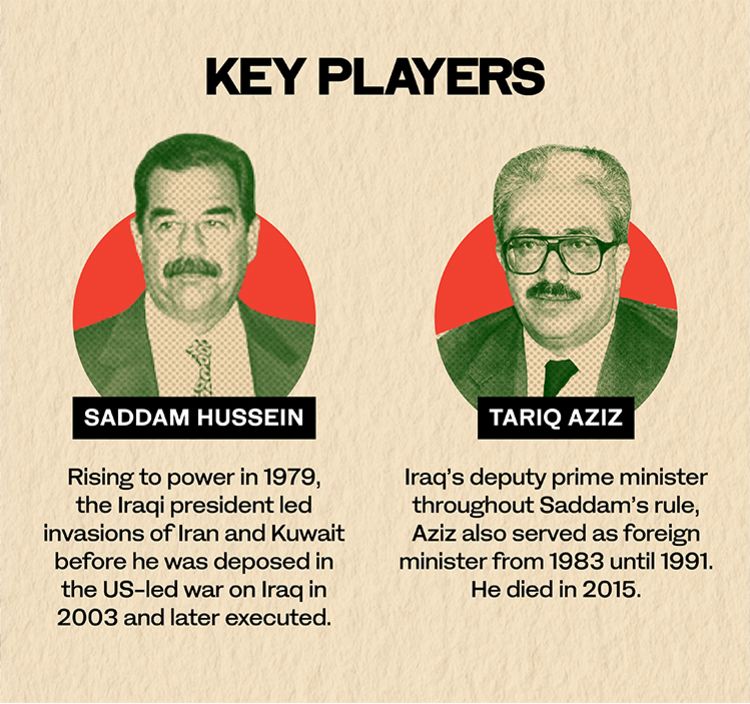
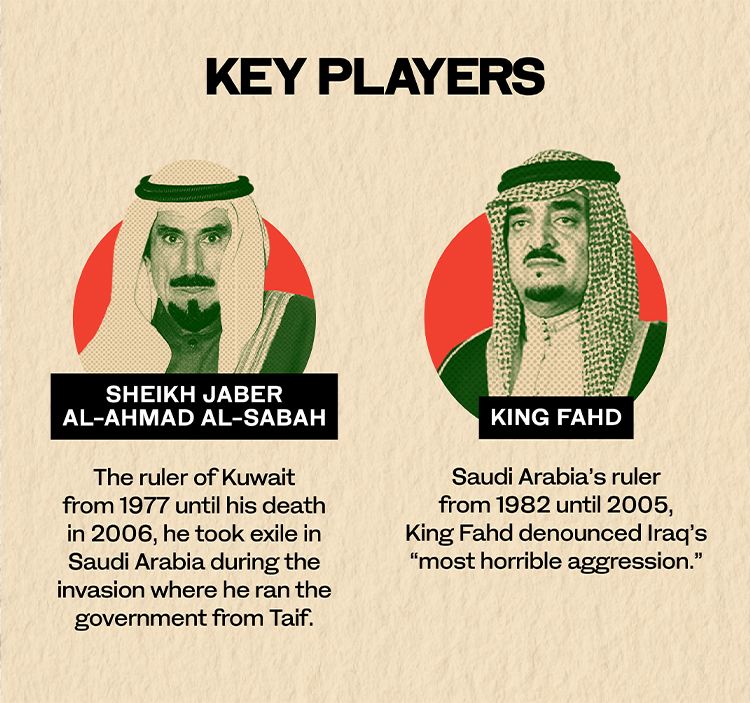
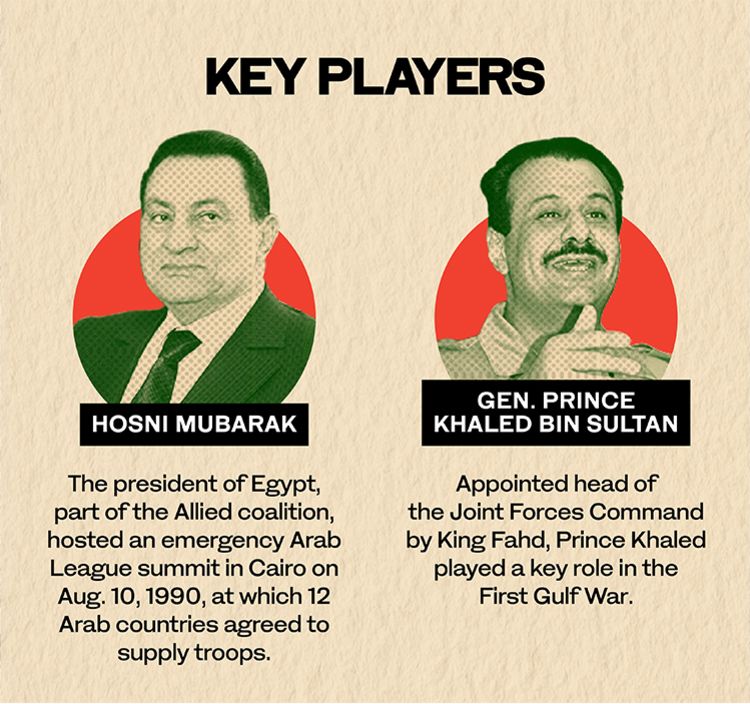
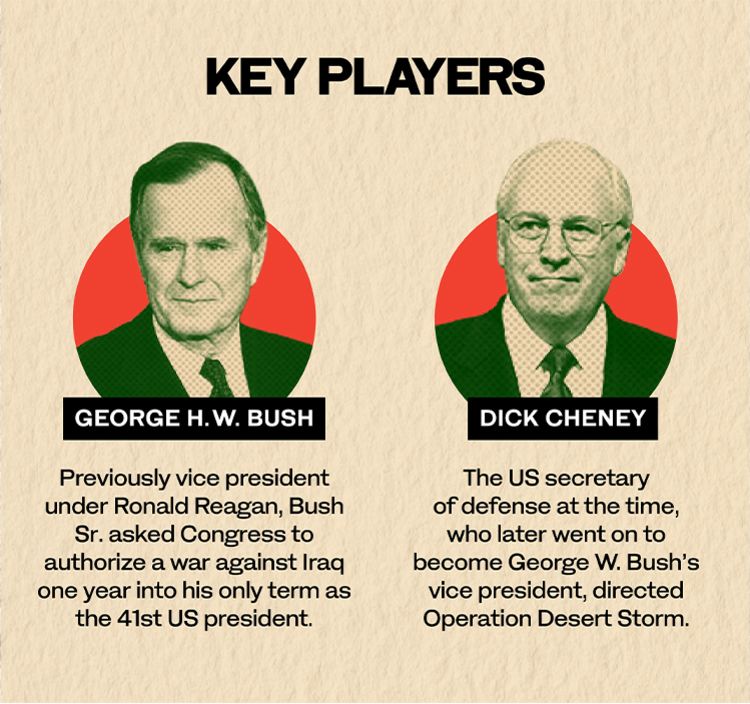
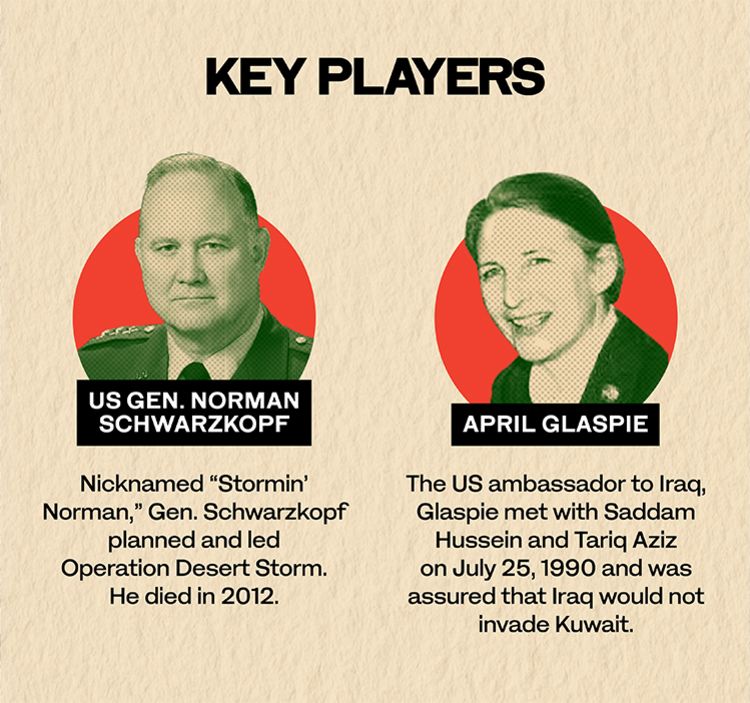

Iraqi soldiers clash with Iranian troops along the Iran-Iraq border in July 1984, midway through the eight-year war between the two countries. (Getty Images)
Iraqi soldiers clash with Iranian troops along the Iran-Iraq border in July 1984, midway through the eight-year war between the two countries. (Getty Images)

Iraqi President Saddam Hussein during an Arab summit in Jordan in November 1980. (Getty Images)
Iraqi President Saddam Hussein during an Arab summit in Jordan in November 1980. (Getty Images)

Egyptian President Hosni Mubarak greets Saudi King Fahd upon his arrival in Cairo on Aug. 9, 1990 for an emergency Arab summit to discuss Iraq's invasion of Kuwait. (AFP)
Egyptian President Hosni Mubarak greets Saudi King Fahd upon his arrival in Cairo on Aug. 9, 1990 for an emergency Arab summit to discuss Iraq's invasion of Kuwait. (AFP)
The invasion of Kuwait

Late in the evening of Aug. 1, 1990, Saudi Gen. Prince Khaled bin Sultan was at home on his farm near Riyadh, entertaining friends after a day spent at Air Defense headquarters.
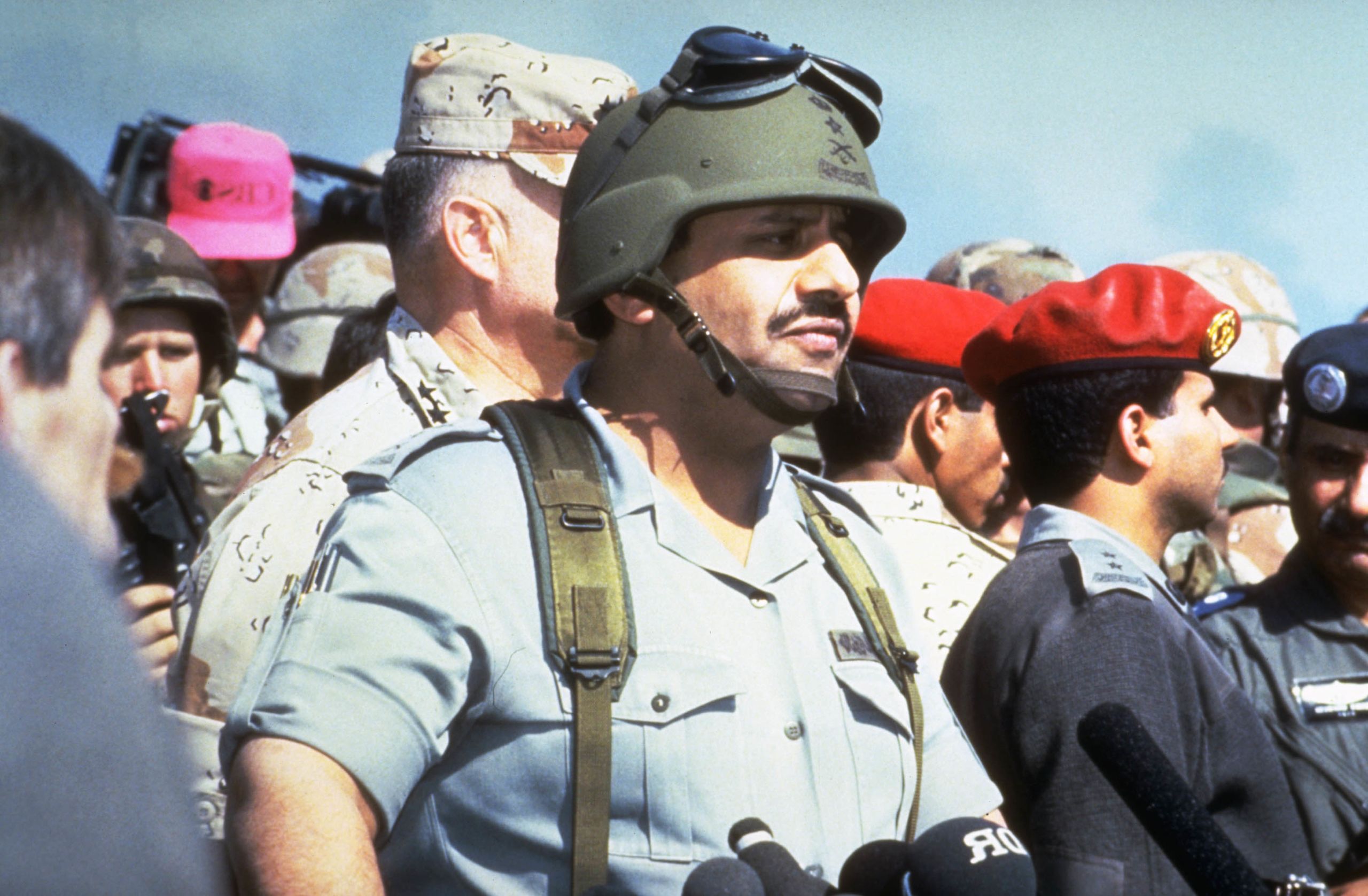
Gen. Prince Khaled bin Sultan, commander of the Joint Forces in Saudi Arabia, during Operation Desert Storm. Behind him is US Gen. Norman Schwarzkopf. (Getty Images)
“War was the farthest thing from my mind that August evening,” the general recalled in an article written in 1993 for the journal of the Royal United Services Institute (RUSI), the London-based international defense and security think tank. “We were still sipping coffee after a barbecue dinner when the phone rang and I got the news that Kuwait was under attack.”
His first reaction was “disbelief. Arabs may disagree, but they don’t usually invade each other.”
In an interview in Arabic with Al Arabiya on Feb. 16, 2021, Raghad Hussein, Saddam Hussein’s daughter, refused to condemn her father when she was asked why he had decided to invade Kuwait and whether she thought he made a mistake in doing so.
“They sinned against us and we sinned against them,” she said. “The two parties mutually wronged each other. The brothers fought and sinned against each other.”
It was not, she added, “an easy phase. We have friendly and brotherly ties with Kuwait. Some of their family members are friends of ours. This decision was not easy for us as a family [and] I guess it was not easy for my father either.”
Iraq, she said, had been alone at the time, and “we lost martyrs by the hundreds. The media only mentioned the martyrs of the other side, may God have mercy on their souls. They lost a lot of martyrs too [but] both sides lost and both countries paid their share of blood.”
The tanks rolled over the border into Kuwait in the very early hours of the morning on Aug. 2, and by 4 a.m. Iraqi special forces were at the gates of Dasman Palace.
In Jeddah, Arab News’ Editor in Chief Khaled Almaeena was woken by an early-morning phone call. “Mohammed Ali, the teleprinter operator at Arab News, was on the line,” he recalled.
“In those days, the teleprinter brought us the news, sometimes in trickles and sometimes in floods. Ali told me that information was trickling in about Kuwait being invaded by Iraqi troops.”
Almaeena arrived at the office at about 6 a.m. “We started reading the reports. In those days, communication was far from quick. There was no internet and no mobile phones.” To get a firsthand report, “I called one of my friends in Kuwait. He said: ‘Yes, I see Iraqi tanks in the streets’ … We maintained contact for about three and a half hours before his phone went dead.”
Later, Arab News would be the first newspaper to enter liberated Kuwait, while the oil wells sabotaged by the retreating Iraqis were still burning.
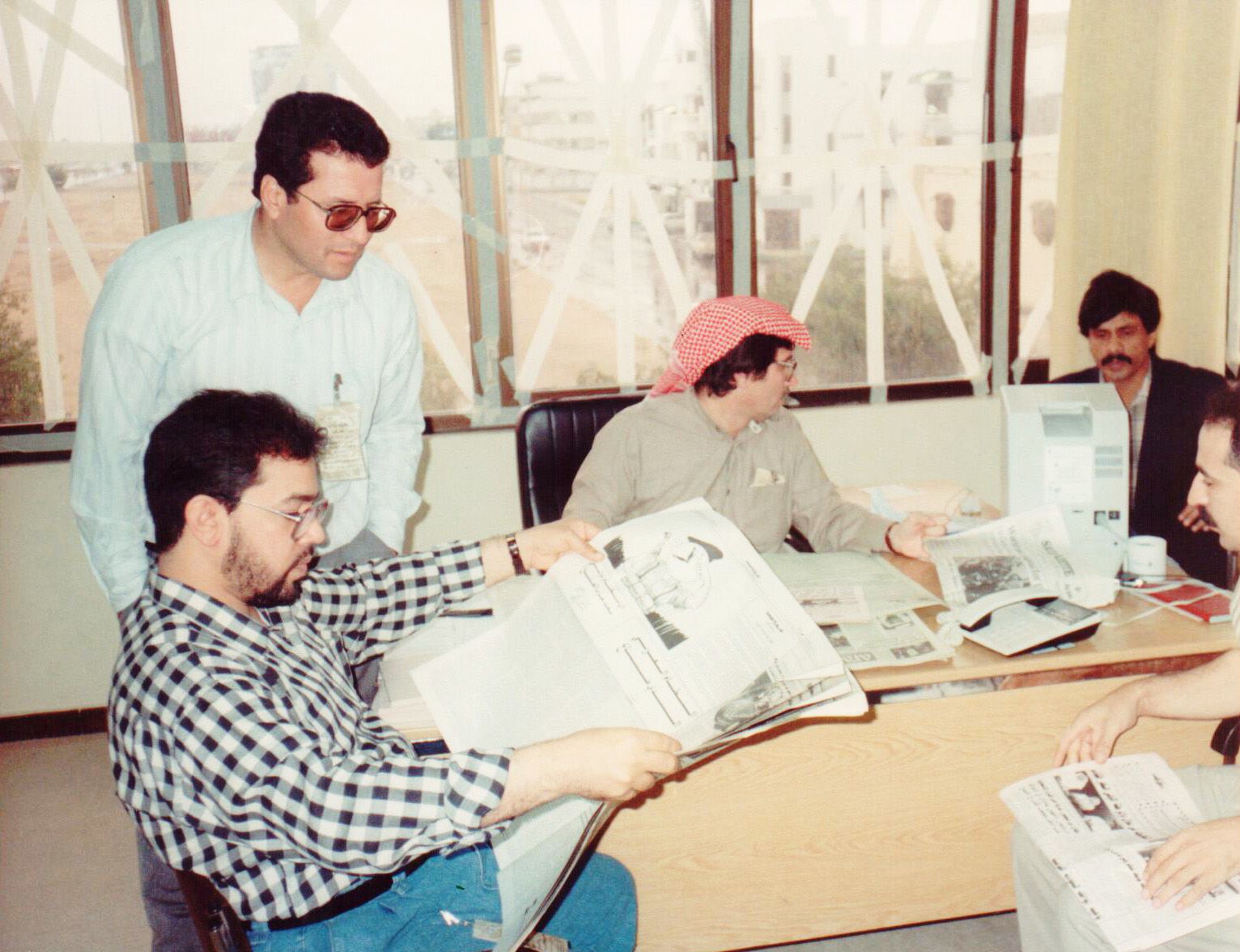
Arab News at work during the Gulf War. From left: Wahib Ghurab, Maher Abbas, Khaled Almaeena and Saeed Haider, the Eastern Province bureau chief. The windows are taped to reduce the threat from flying glass in the event of an explosion.
Arab News at work during the Gulf War. From left: Wahib Ghurab, Maher Abbas, Khaled Almaeena and Saeed Haider, the Eastern Province bureau chief. The windows are taped to reduce the threat from flying glass in the event of an explosion.
The surprise attack was the beginning of a seven-month ordeal of occupation for Kuwait and a race by coalition forces to build up sufficient strength to prevent Saddam from sweeping into Saudi Arabia and the other Gulf oil states.
According to later accounts by Iraqi prisoners of war, Saddam’s special forces had been tasked with seizing Dasman Palace and capturing or killing the Kuwaiti Emir, Sheikh Jaber Al-Ahmad Al-Sabah.
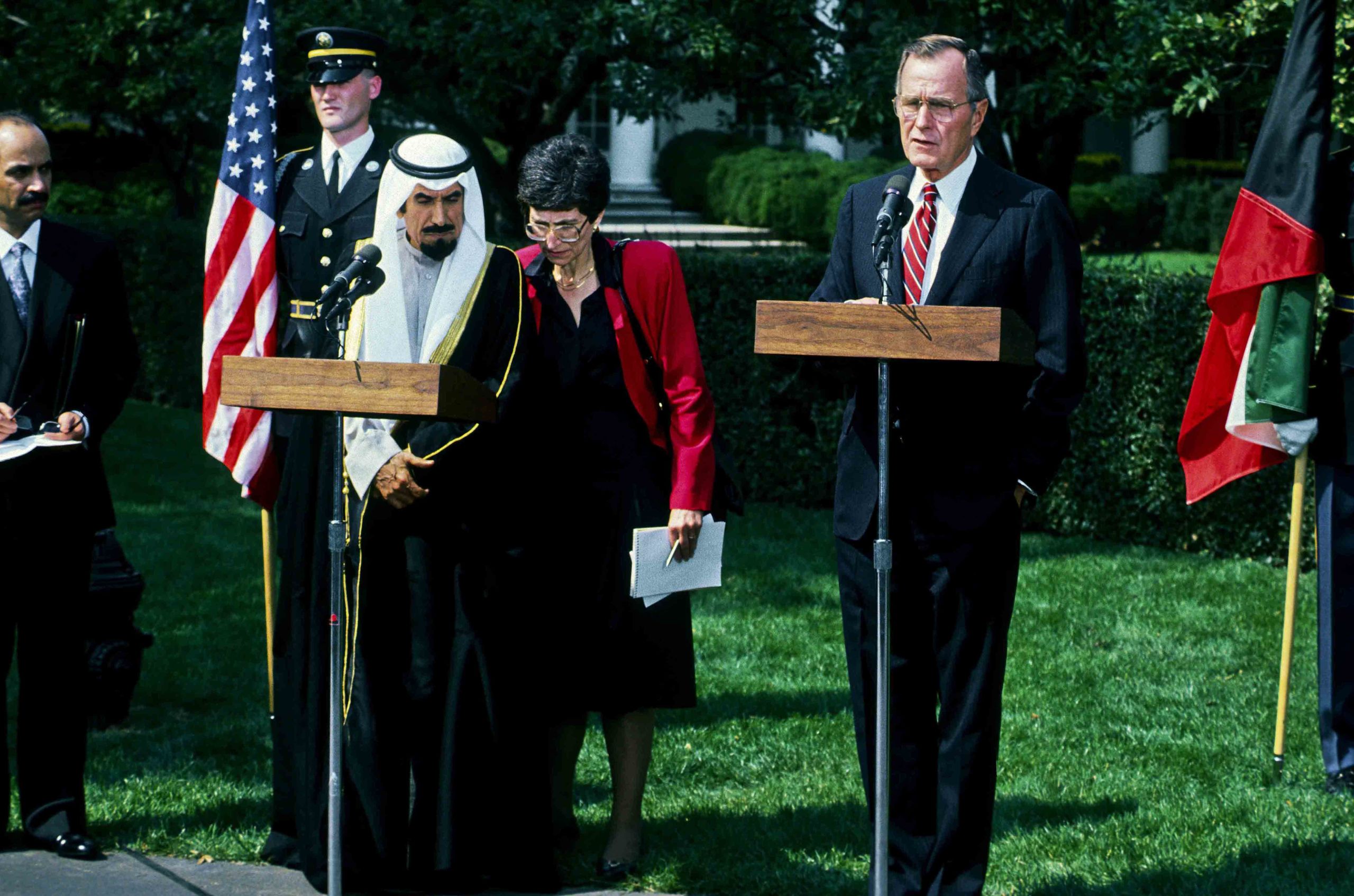
Exiled Kuwaiti Emir Jaber Al-Ahmad Al-Sabah appears with US President George H. W. Bush on the South Lawn of the White House on Sept. 28, 1991. (Getty Images)
Alerted just in time, the emir and members of his family had quickly left the palace and driven the 70 kilometers to the Saudi border. Not all the Al-Sabah family escaped with their lives. Among the casualties in the brief but bloody battle for control of the palace was the emir’s younger brother, Sheikh Fahad Al-Ahmad Al-Jaber Al-Sabah, who was reported to have died in its defense.
Kuwait’s small and heavily outnumbered army was taken largely by surprise as more than 100,000 Iraqi troops and 700 tanks, backed by fighter aircraft and helicopters, poured over the border.
As an exhaustive Pentagon report on the conduct of the Gulf War concluded in April 1992, “Kuwaiti military resistance was uncoordinated” and, “despite individual acts of bravery, Kuwaiti forces were hopelessly outmatched.”
Outmatched, perhaps, but stubborn. Bad weather at Iraqi airfields delayed for about an hour the takeoff of squadrons tasked with destroying the Kuwaiti air force on the ground, and Kuwait’s pilots took advantage of the brief reprieve to get airborne.
The small Kuwaiti air force concentrated on attacking the fleets of helicopters, described by one eyewitness as resembling a swarm of bees, that were ferrying Iraqi troops over the border. Flying French Mirage F1 fighters and US-made McDonnell Douglas A-4 Skyhawks, Kuwaiti pilots shot down more than 20 helicopters, at least seven Russian-made fighter aircraft and an Ilyushin military cargo plane.
The pilots fought on even after Iraqi aircraft bombed the runways at Ahmad Al-Jaber Air Base, rendering them inoperable. Only when Iraqi ground troops finally overran Kuwait’s airbases did the pilots fly their aircraft to Saudi Arabia. Later, they would play a valiant part in the coalition effort to liberate their country.
Kuwait’s overwhelmed army fought a series of isolated running battles before survivors also crossed into Saudi Arabia, regrouping at Hafr Al-Batin, some 230 kilometers from Kuwait City.
An account published in 1995 in the US Army training bulletin Armor told the story of the Battle of the Bridges, in which the 35th Shaheed Brigade, consisting of two tank battalions equipped with British Chieftain tanks, inflicted heavy casualties on the Iraqis in a series of battles fought on and around Highway 70, west of the town of Al-Jahra, where the attacking forces were concentrating before sweeping into the capital.
Having destroyed a number of enemy tanks and pinned down several Iraqi units for most of the day, killing an unknown number of Iraqi soldiers in the process, toward evening the brigade also withdrew to the Saudi border, where it took up defensive positions before crossing over to safety the following morning.
The precise number of combat casualties on either side during the day-long conquest of Kuwait is unknown, but some estimates suggest about 300 Iraqi and over 400 Kuwaiti combat troops were killed.
Within days of the attack much of the population of Kuwait, including thousands of foreign nationals, had fled the country. Over two months, the Indian government pulled off what remains the biggest airlift in history, with Air India operating a total of almost 500 flights to bring home 100,000 citizens from Kuwait and Iraq.
Other expatriates, including Western oil workers and their families, were not so lucky. Some 4,000 Britons and 2,500 Americans were rounded up and some were taken to Iraq, where Saddam used them as human shields to deter aerial attacks on key military targets.
John Levins, an Irish-Australian accountant who had been working in Kuwait for five years, heard about the invasion in a 5:40 a.m. phone call from a friend.
“I was in an apartment on the eighth floor in the city center,” he recalled. “I looked out of the window and saw Republican Guard infantry rounding up and disarming the police officers who had been stationed outside the Saudia airline offices opposite.”
He heard gunfire in the distance but the Republican Guard, he said, “were extremely professional” with the expats they encountered. They were soon withdrawn, however, and when conscripted Iraqi troops took their place “that’s when the looting started.”
Curiously, Levins recalled, “the Iraqis left the Western embassies alone, although they cut their power, water and phone lines. They told the staff to move to Baghdad because as a province of Iraq there was now no need for embassies in Kuwait City. But the diplomats stayed, saying they still had consular responsibilities to their nationals in a time of crisis.”
The US and UK embassy staffs, surviving on emergency stocks of water and food and communicating via fax lines, remained in the city until the first week in December 1990, by which time the Iraqis had let all the foreign hostages go.
In August, a publicity stunt by Saddam backfired when Iraq released footage of him posing with a five-year-old British boy, Stuart Lockwood, whose father had been working as a chemical engineer in Kuwait at the time of the invasion. The boy, clearly afraid, refused to sit on the president’s knee and the footage of Saddam ruffling his hair earned the dictator the contempt of the global community.
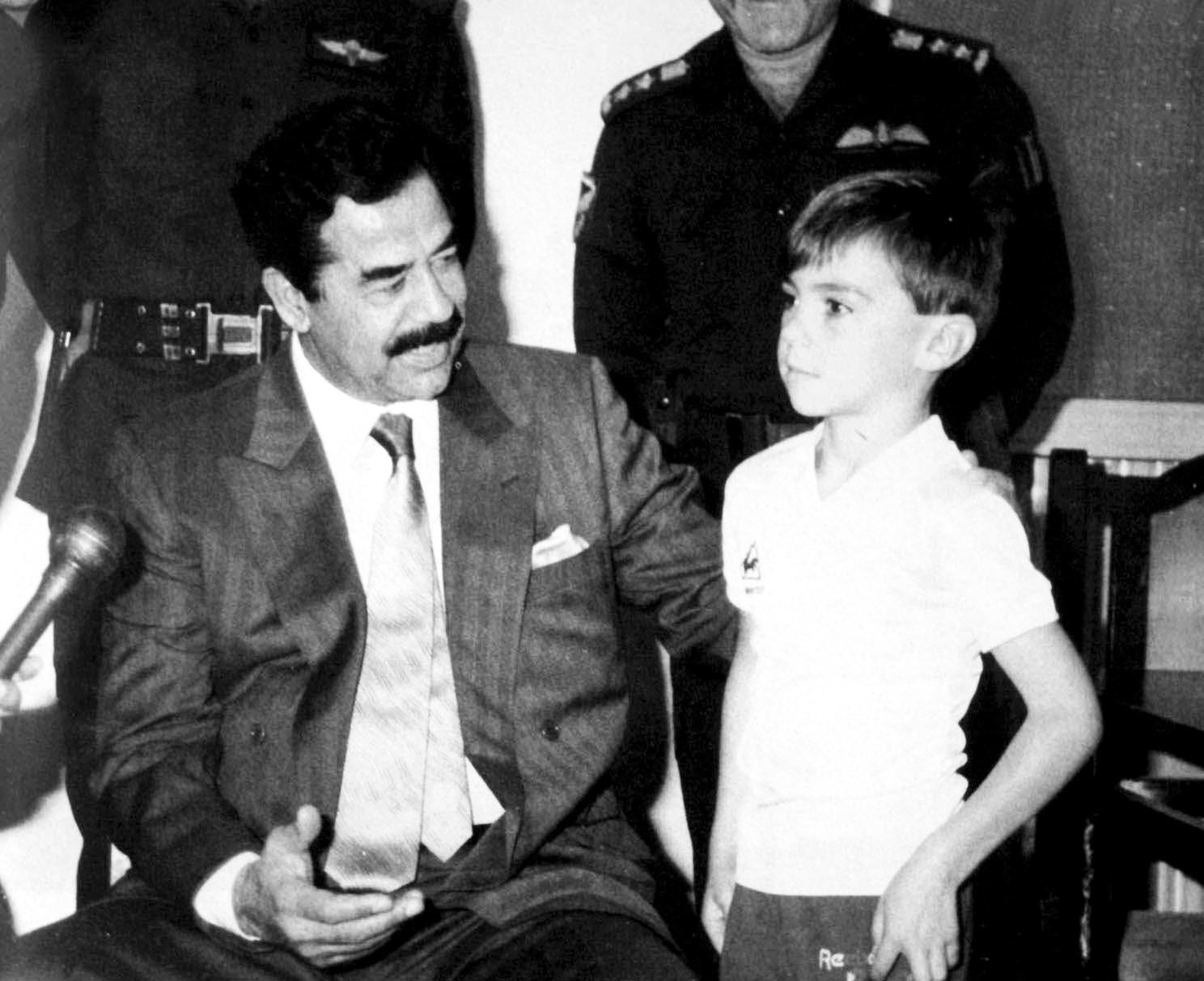
A publicity stunt by Saddam backfired when Iraq released footage of him posing with a frightened 5-year-old British boy whose father had been working in Kuwait. (Shutterstock)
A publicity stunt by Saddam backfired when Iraq released footage of him posing with a frightened 5-year-old British boy whose father had been working in Kuwait. (Shutterstock)
Some foreigners flew into trouble even as the invasion was taking place. In the early hours of the attack, British Airways Flight 149, flying from London to Kuala Lumpur, touched down at Kuwait for a scheduled refueling, its crew apparently unaware that the country had been invaded.
It was the beginning of a four-month ordeal for the 300 passengers and crew, including a 10-year-old American girl who had been traveling alone, many of whom were shuttled around Kuwait and Iraq as “guests” of Saddam Hussein.
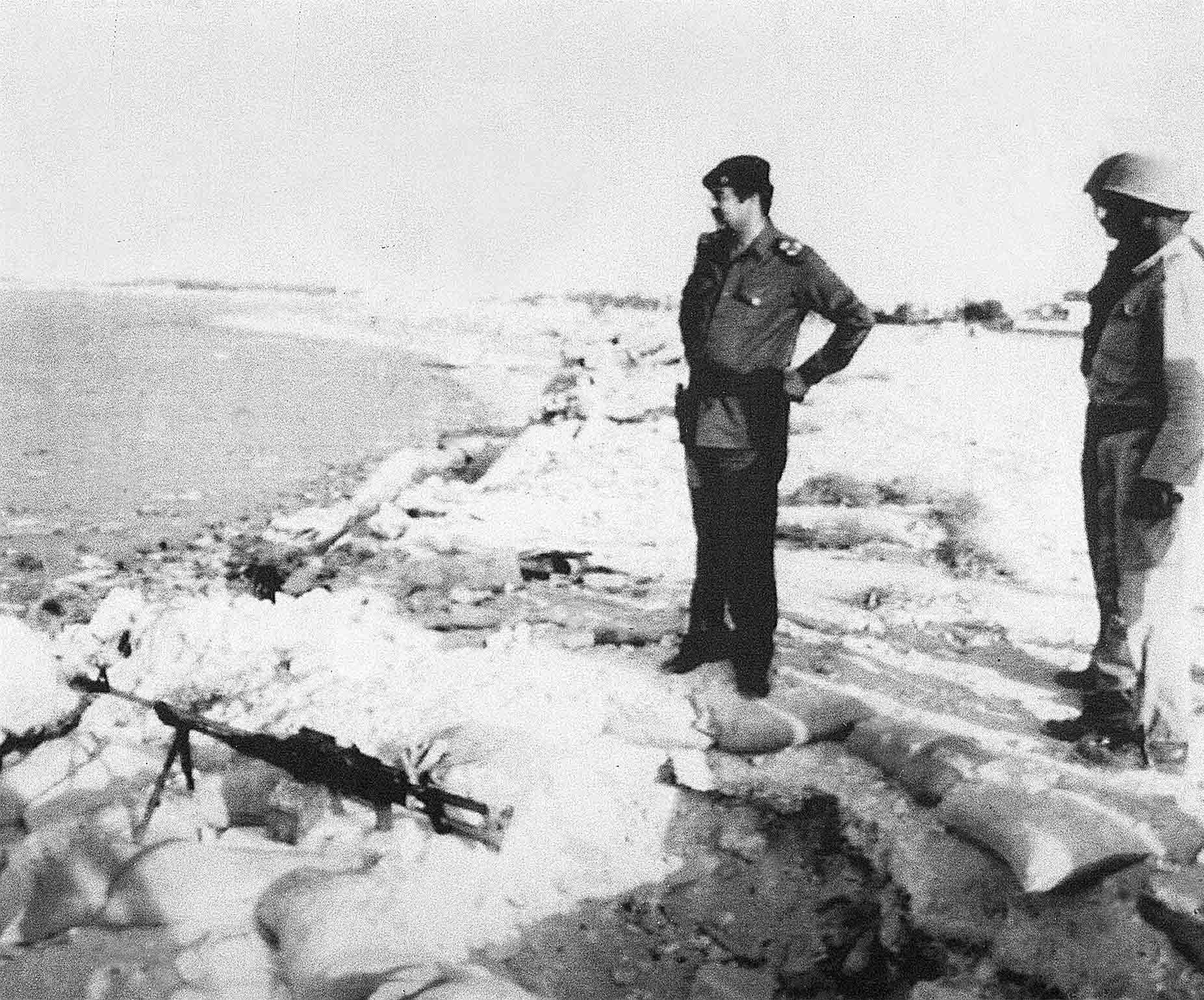
President Saddam Hussein inspects an Iraqi position in Kuwait on Oct. 3, 1990, according to information provided by the official Iraq News Agency. (AFP)
Some of the passengers ended up as human shields in Iraq. Others were tortured or subjected to mock executions, while some women were raped. Passengers also witnessed atrocities, including the summary execution of a Kuwaiti soldier and incidents in which cars with Kuwaiti civilians inside were driven over by tanks.
Levins, who was able to leave Kuwait in December 1990, told the story of the heroism of the ordinary Kuwaitis who resisted the invasion in an article published in the journal Middle East Quarterly in 1995.
It was, he wrote, “difficult to find words that do justice to the Kuwaiti resistance of 1990-91, the remaining untold story of a great international crisis.”
Levins quoted Ahmad Ar-Rahmani, a lieutenant colonel in the Kuwaiti army, who paid tribute to his fellow Kuwaitis. “In Kuwait, everyone from children to old men resisted,” he said. “There were no Kuwaiti puppets which Iraq could use to form a government. Every Kuwaiti was in the resistance.”
Acts of defiance ranged from spraying anti-Iraqi graffiti, which began to appear all over Kuwait from the first morning of the occupation, to demonstrations, a refusal to obey instructions to return to work, sabotage of the invaders’ efforts to steal and later destroy oil stocks, and overt military attacks on the occupiers.
“Many Kuwaitis consider women to have been the backbone of the resistance,” wrote Levins. Some women smuggled weapons and ammunition through checkpoints, while others took part in even more dangerous activities.
One was 30-year-old Asrar Al-Qabandi, “the great heroine of the Resistance,” who on one of her first missions smuggled 15 children of the royal family out of the country. She was captured in the first week of November 1990. Chained and tortured, she was finally executed on Jan. 13 or 14, 1991.

Asrar Al-Qabandi, known as the great heroine of the Kuwaiti resistance, was executed by the Iraqis in January 1991.
Asrar Al-Qabandi, known as the great heroine of the Kuwaiti resistance, was executed by the Iraqis in January 1991.
A cable to Washington from US diplomats in Saudi Arabia on Nov. 22, 1990 reported that the invasion “and subsequent Iraqi brutalities in Kuwait literally drove Kuwait into Saudi Arabia. Thousands of refugees and the bulk of Kuwait’s government arrived on the scene in need of support and sustenance. The Saudis were and remain generous with both.”
For the Saudis, offering sanctuary to the Kuwaitis was a historic debt of honor. The Saudis, the dispatch added, “openly recalled the Sabah family (and Kuwaiti) support for the Sauds during their exile from Saudi Arabia earlier in the century and they made clear they were standing by their friends in need during this crisis.”
This was a reference to a foundational episode in the story of Saudi Arabia. In 1891, the Second Saudi State, weakened by decades of conflict with the powerful Ottoman Empire, was driven out of Riyadh by the rival Rashidi dynasty. Al-Saud members were offered sanctuary by Sheikh Mohammed Al-Sabah, the ruler of Kuwait. Among their number was a young man named Abdul Aziz bin Abdul Rahman bin Faisal Al-Saud, better known to the world as Ibn Saud, who in 1902 would lead a small band of warriors back to Riyadh to reclaim his birthright and set Saudi Arabia on the path to nationhood.
Now, almost 90 years later, the Kingdom was in a position to return the favor. “There were a lot of Kuwaitis who came to Saudi Arabia when the invasion started,” recalled Hatoon Majdi Al-Toukhi, a Saudi chef in Jeddah who was a 12-year-old living with her family in Riyadh when the Iraqi army invaded Kuwait.
“The government provided them with apartments for free. I remember passing by these buildings. My parents made sure to tell us that the Kuwaitis have been sheltered in these buildings and they’re living here to be secure.
“I remember hearing a lot of stories about what Saddam was doing to the Kuwaitis back then and we were so scared. This was the biggest fear — what if he invaded Saudi Arabia ... this could happen to us.”
Even as the Kingdom extended a helping hand to Kuwait, all Saudi Arabia found itself contemplating its own vulnerability in the face of Iraq’s wholly unexpected aggression.
“When King Fahd appointed me to head the Joint Forces Command,” recalled Prince Khaled in his RUSI memoir, “I inspected my headquarters staff. That was easy enough, because he was standing at my elbow. My Adjutant was my entire staff, and we were about to put together a complex operation to stop a terrible dictator.”
The general’s first concern was for “the immediate security of Saudi Arabia, whose northern approaches were totally exposed.” Iraq was supposed to be Saudi Arabia’s ally and consequently, the Kingdom had only two brigades along its northern border — a border along which vast Iraqi forces were now massing.
Had Saddam attacked then, as the general later acknowledged, “in those nerve-shattering days of August and September 1990 there was little we could have done, and dislodging him from the Eastern Province would have been a far more daunting task than Desert Storm.”
Measured against the Saudi forces, Saddam’s army, the fourth largest in the world, was formidable. “We knew this more than most — we had helped to build it,” wrote Prince Khaled. “We faced overwhelming superiority in manpower and firepower [and] the forces of the Gulf Cooperation Council were not strong enough to change the equation.”
One army was, however. In Washington, early on the morning of Aug. 2, John H. Kelly, the assistant secretary of state with responsibility for Near East and South Asian affairs, called in Iraqi Ambassador Mohammed Sadiq Al-Mashat. He told him the invasion was “a violation of the UN charter and all norms of civilized behavior” and that Iraq must “cease the invasion and withdraw its forces immediately.”
The US was reacting swiftly. By 9:34 a.m. Washington time on the day of the invasion, it had frozen all Kuwaiti government assets within US jurisdiction or under the control of Americans or American companies to prevent them from falling into Iraqi hands and requested that all other nations do the same. At the same time, it froze Iraqi assets, terminated all commercial contracts and banned all exports and imports.
In the US, military preparations were already under way. Within an hour of the Iraqi attack, two aircraft carriers and their battle groups had been ordered to the region, the USS Independence steaming for the Gulf of Oman from the island of Diego Garcia in the Indian Ocean and the USS Dwight D. Eisenhower heading toward the Red Sea via the Mediterranean. Together, they carried over 100 combat aircraft.

Gen. Prince Khaled bin Sultan, commander of the Joint Forces in Saudi Arabia, during Operation Desert Storm. Behind him is US Gen. Norman Schwarzkopf. (Getty Images)
Gen. Prince Khaled bin Sultan, commander of the Joint Forces in Saudi Arabia, during Operation Desert Storm. Behind him is US Gen. Norman Schwarzkopf. (Getty Images)

Exiled Kuwaiti Emir Jaber Al-Ahmad Al-Sabah appears with US President George H. W. Bush on the South Lawn of the White House on Sept. 28, 1991. (Getty Images)
Exiled Kuwaiti Emir Jaber Al-Ahmad Al-Sabah appears with US President George H. W. Bush on the South Lawn of the White House on Sept. 28, 1991. (Getty Images)

President Saddam Hussein inspects an Iraqi position in Kuwait on Oct. 3, 1990, according to information provided by the official Iraq News Agency. (AFP)
President Saddam Hussein inspects an Iraqi position in Kuwait on Oct. 3, 1990, according to information provided by the official Iraq News Agency. (AFP)
A pair of US Air Force KF-135 midair refueling tanker aircraft that, by coincidence, had been in the UAE since July 23, were ordered to remain there in support of the Emirati air force, which was flying combat air patrols over the country’s oil facilities.
On Aug. 4, Saddam installed Alaa Hussein Ali, a lieutenant in the Kuwaiti army with dual nationality, as head of a nine-member puppet government. It lasted only until Aug. 28, when Saddam announced Kuwait had been annexed as the 19th province of Iraq, renaming Kuwait City Kadhima. Ali, who fled during Desert Storm, was later sentenced in absentia by Kuwait to death for treason. He returned in 2000 to appeal his sentence, which in 2001 was commuted to life in prison.
Saddam then appointed one of his cousins, Ali Hassan Al-Majid, as governor of the new “province.” As head of the Ba’ath Party’s Northern Bureau, Al-Majid had earned a gruesome reputation for his bloody suppression of the Kurdish rebellion in northern Iraq between 1987 and 1988. Among the Kurds, he earned the nickname “Chemical Ali” for his use of chemical weapons, including sarin and mustard gas, against civilian targets. In March 1988, some 5,000 were gassed to death in the town of Halabja and, by the end of that year, an estimated 180,000 Kurds had been killed.
Justice would catch up with Al-Majid. He was captured by US troops after the fall of Iraq in 2003 and, sentenced to death by an Iraqi court for crimes against humanity, was hanged on Jan. 25, 2010.
At the UN in New York, on the day of the invasion, the US sponsored a resolution that was passed unopposed by the Security Council. Resolution 660, the first of a dozen over the next five months, imposed sanctions in Iraq, condemned the invasion and demanded that “Iraq withdraw immediately and unconditionally all its forces to the positions in which they were located on 1 August 1990.”
On Sunday, Aug. 5, President Bush, returning to Washington from Camp David after a day of telephone diplomacy, spoke to reporters on the South Lawn of the White House about the “intensive diplomatic activity” that was going on around the world. None of America’s allies, he said, were “willing to accept anything less than total withdrawal from Kuwait of the Iraqi forces, and no puppet regime.”
He ended his remarks with a clear warning for Saddam Hussein, which made headlines around the globe: “This will not stand, this aggression against Kuwait.”
The very next day, US Secretary of Defense Dick Cheney flew to Jeddah to meet with Saudi Arabia’s King Fahd. With him went the commander of US Central Command (CENTCOM), responsible for military operations in the Middle East, a decorated Vietnam veteran who would soon become a household name — Gen. Norman Schwarzkopf.
By chance, as Schwarzkopf would later recall, although the timing of the Iraqi attack had taken everyone by surprise, for the past year CENTCOM had been “wargaming” a scenario remarkably similar to the one that was now unfolding.
“We always knew the precursor to an overall [Iraqi] attack taking over the entire Gulf would be the taking of Kuwait first,” Schwarzkopf later told PBS. “Hussein’s threats were against both Kuwait and the United Arab Emirates, and the only way to get to the UAE would have been through Saudi Arabia.”
Saudi Arabia was now extremely vulnerable. The Americans were keenly aware they had insufficient forces in the region to prevent an Iraqi invasion of the Kingdom and that, before they could even think about building up their numbers, they needed the permission and support of the Saudis.
“It was absolutely necessary to have the Saudis’ permission to come in because of the number of forces we were going to bring,” Schwarzkopf later said, “and it was absolutely necessary to have their approval because we very much needed to use their equipment.”
Most importantly, the Americans knew they had only a narrow window of time in which to act. This was the stark message they carried with them into their meeting with King Fahd on Aug. 7.
There was, Cheney later recalled, “very little small talk — we went right straight to the issue,” and the king listened attentively throughout the two-hour meeting.
Cheney told the Saudis “that it was very hard for us to be able to help them unless we could get plenty of advance time because it takes a long time to move heavy forces halfway around the world.”
Next, Gen. Schwarzkopf showed the Saudis aerial photographs of the large numbers of Iraqi tanks massed on the Kingdom’s borders. Some, in fact, were actually already positioned on Saudi territory and, even though “it was on a piece of sand out in the middle of nowhere,” Schwarzkopf recalled, the King “was infuriated that the sovereignty of Saudi Arabia had been violated.”
Then the general explained exactly how many aircraft, troops and ships the US wanted to bring in to defend the Kingdom — a vast number. At this point, Cheney stepped in to reassure the Saudis that the US presence would last only as long as necessary and that, once the threat was removed, all American assets would be withdrawn.
Having made their case, the Americans waited while the King consulted with several members of the royal family. According to Schwarzkopf, Charles W. Freeman, the Arabic-speaking US ambassador to Saudi Arabia, later told the CENTCOM commander and Cheney that at one point during the short but animated discussion, the King was heard to say, “the Kuwaitis are all living in our hotels right now because they weren’t willing to make a decision in this matter and I’m not going to have that happen.”
The Americans had expected they would have to wait several days for a reply through diplomatic channels. Instead, recalled Schwarzkopf, “at the end of that discussion, the King turned and said, ‘Okay,’ and I almost fell out of my chair.”
What followed was one of the most spectacular and rapid deployment of troops, tanks, artillery, ships and aircraft since the Second World War. King Fahd appointed Prince Khaled commander of what became the Joint Forces Command, the Arab military organization that would help to mastermind and execute the defense of Saudi Arabia and the liberation of Kuwait.
The King’s decision to call in the US, recalled Prince Khaled in 1993, was a historic and courageous act. “You have to be a Muslim,” he wrote, “to appreciate the unprecedented courage and the iron will that went into the decision to invite Western forces into Saudi territory, the Islamic world’s holy of holies.”
One of the general’s most pressing problems was “how to reconcile the need for foreign forces on Saudi soil and the Islamic nature of that soil.” It was “of the utmost importance that the massive multinational, multi-cultural, multi-religious mobilization in the Kingdom not be perceived in any way as an encroachment on Islam, its holy place and its values — there were Islamic principles, customs and traditions that had to be respected and observed.”
In the end, Prince Khaled was impressed by the mutual respect that was demonstrated by the members of the no fewer than 37 different armies who came together in Saudi Arabia — and by the response of the citizens of the Kingdom.
“Western tolerance was matched by Saudi tolerance,” he recalled. “The people of Saudi Arabia rose to the occasion in a manner that filled me with pride. They realized what was at stake, and they made the allowances that had to be made.”
At 2 p.m. Saudi time on Aug. 9, King Fahd made a televised speech to the nation, condemning the invasion and calling on Iraq to withdraw immediately and unconditionally. After outlining all the diplomatic efforts that were being made to end the crisis, by the Kingdom and other players, including the Arab League, he spoke of the critical need to protect the Kingdom and thanked “the US, UK and other friendly countries” that were responding to Saudi Arabia’s appeal for help.
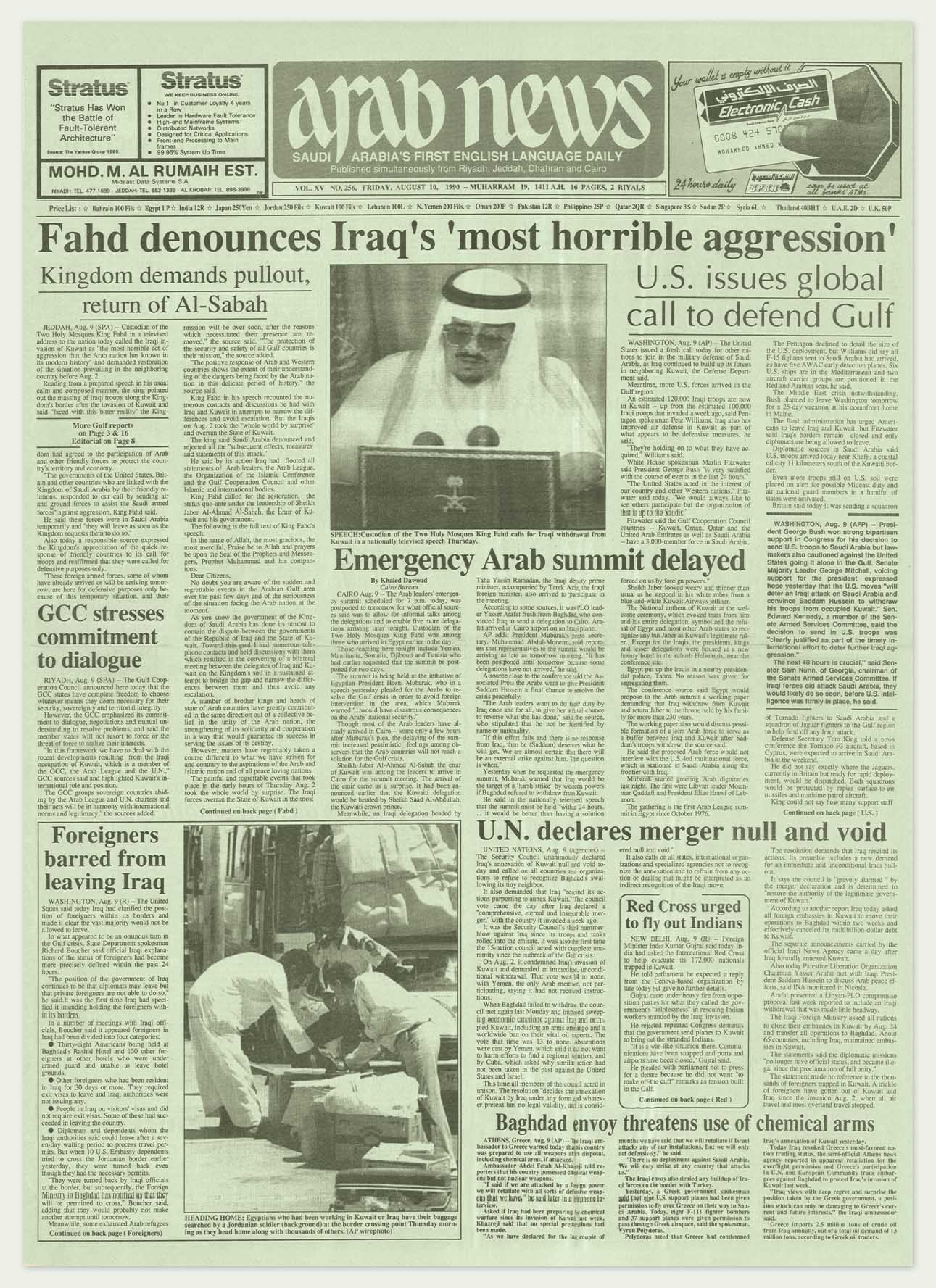
The Arab News front page of Aug. 10, 1990 reports King Fahd’s denunciation of Iraq’s “most horrible aggression.”
Keenly aware of the sensitivities involved, the King stressed that the Kingdom was unable to mount a defense on its own against Iraq’s numerically superior and battle-hardened army but offered an assurance that the Western support would be only temporary and that all foreign forces would leave “as soon as the Kingdom requested.”
Within 12 hours of King Fahd having given the go-ahead, US F-15 fighter aircraft began arriving in Saudi Arabia, having flown non-stop for 14 hours from Langley Air Force Base in Virginia with seven midair refueling. By Aug. 9, the aircraft were flying combat patrols along the Saudi border, supported by airborne reconnaissance and early-warning aircraft flown in from the US and Europe.
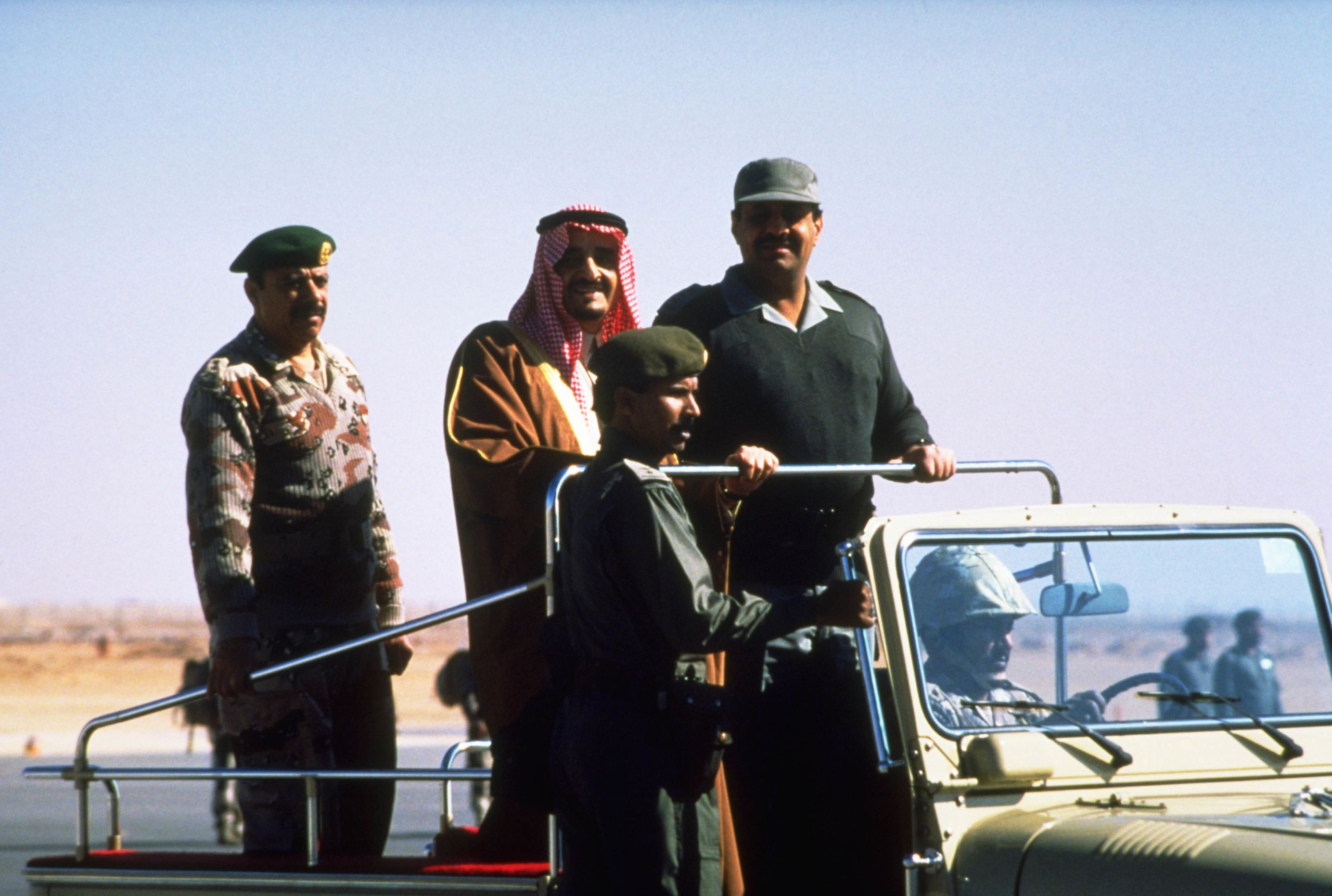
Saudi Arabia’s King Fahd and Gen. Prince Khaled bin Sultan review troops of the Royal Saudi Landing Force in 1991. (Getty Images)
That same day, just two days after the Jeddah meeting, the first 2,500 men of the 15,000-strong 82nd Airborne Division arrived in Saudi Arabia from Fort Bragg, North Carolina, and immediately threw a defensive perimeter around the airport at Dhahran. A second brigade arrived within days.
It was not a moment too soon. By then, the number of Iraqi divisions in Kuwait had swollen from four to 11, “far exceeding occupation requirements,” in a Pentagon assessment, and “more than enough forces to launch an immediate invasion of Saudi Arabia.”
For weeks, the Saudis and the Americans knew it would be touch and go. The 82nd Airborne, as both Schwarzkopf and the troops themselves recognized, would just be “speed bumps” on the road if Iraqi forces attacked before the US had built up sufficient strength.
The nightmare scenario, recalled Schwarzkopf later, was that the Iraqis would “continue their attack at that time and sweep through those oilfields and certainly take the port of Dhahran and the airfield at Dhahran.”
If they did, “they could have swept all the way down the coast … once you’re at Dhahran it would be very easy to go over and take Bahrain and continue on down the coast to take Qatar and also the United Arab Emirates.”
The Americans were also keenly aware that Saddam had at his disposal, and had previously used, chemical weapons. In the event, chemical weapons were not used, but one of the abiding images of the war was of coalition forces wearing gas masks and cumbersome chemical warfare suits.
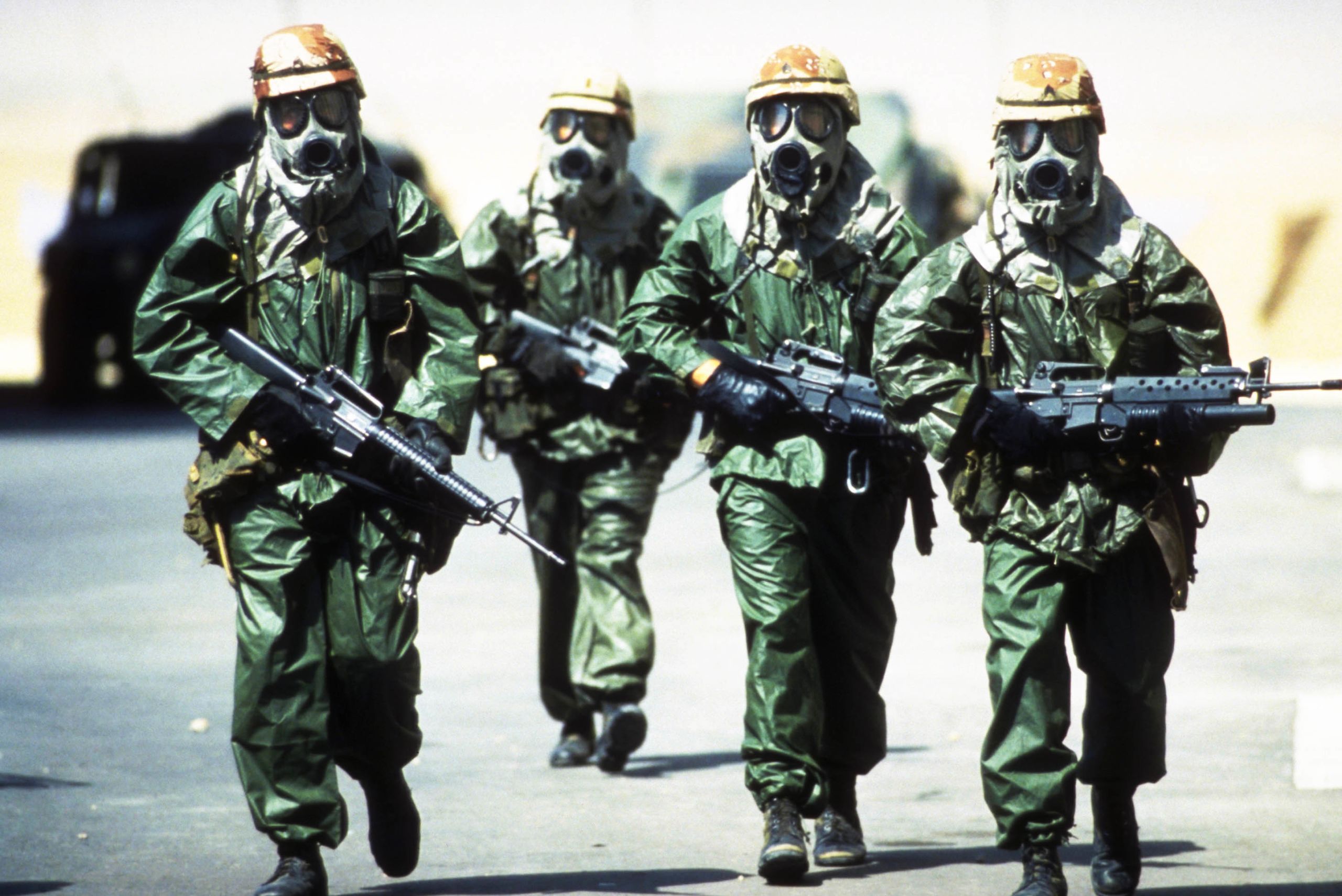
Soldiers from the US 82nd Airborne Division, wearing chemical warfare suits and M-17A1 protective masks, walk around their camp trying to acclimate to the heat of the Saudi summer during Operation Desert Shield in 1990. (Getty Images)
Chillingly, on the American side, “there was always the implicit threat of nuclear weapons,” said Colin Powell, chairman of the joint chiefs of staff under Bush, several years after the Gulf War. “I don’t think we ever would have used them but, nevertheless, the Iraqis didn’t know that. And we could have if provocation was serious.”
The deployment of US forces escalated quickly. By Aug. 11, B-52G bombers and C-130 Hercules aircraft carrying troops and cargo were in the region. On Aug. 12, the 101st Airborne Division began to deploy from Fort Campbell, Kentucky, and on Aug. 14. the 7th Marine Expeditionary Brigade from southern California, complete with its tanks, helicopters and attack aircraft, was unloading at Jubail Port in the Eastern Province.
In just three weeks, the US had deployed seven brigades, three carrier battle groups, 14 fighter squadrons, a strategic bomber squadron and a Patriot missile defense umbrella to the region. But that was just a start. It would be two months before the US military judged it had closed the “window of vulnerability” and was in a position successfully to defend Saudi Arabia.
On the eve of battle, the Iraqis had amassed 540,000 troops, over 4,200 tanks, 2,800 armored personnel carriers, over 3,000 artillery pieces and numerous anti-aircraft batteries and surface-to-air missile systems.
Facing them were an almost identical number of 540,000 US troops, backed by 1,736 combat aircraft, 60 B-52 bombers, two carrier battle groups, numerous warships and several submarines equipped with Cruise missiles.
Fifty countries had rallied to the coalition’s banner, of which 38, including the Gulf states, had deployed air, ground or naval forces, contributing a further 200,000 troops, 60 warships, 750 aircraft and 1,200 tanks.
“They came from all parts of the world, including Arab and Islamic countries,” as the Pentagon post-war report recorded. “Their troops fought side by side with American forces. They faced danger and mourned casualties as did the United States. But they remained firmly committed.”
Daily, Saudi Arabia also pulled off an enormously complex logistical exercise, feeding and supplying millions of gallons of water to 750,000 troops.
What is not always fully appreciated is the financial contribution made by coalition members. Of the eventual cost of the military operation against Saddam Hussein of over $61 billion, US allies provided $54 billion — equivalent to the world’s third-largest defense budget at the time. Two-thirds of this came from the Gulf states.
Kuwait’s five fellow Gulf Cooperation Council (GCC) states, an organization that had been formed in 1981 in response to the Iran-Iraq War, “reacted strongly,” the US Department of Defense later reported. Saudi Arabia, Bahrain, Qatar, the UAE and Oman “committed forces, offered increased access to bases, and provided logistical assistance.” These contributions, “often attended by direct risks of Iraqi reprisals, proved important to the overall effort.”
In Kuwait, meanwhile, following the invasion, volunteers from the Iraqi Popular Army began arriving in the country, along with members of Iraq’s civil and military intelligence organizations. Their mission, according to a later assessment of the war by the US Department of Defense, was “to establish stringent control mechanisms in Kuwait City,” and “they immediately went about their task with unbridled brutality.”
Later, the Kuwaiti government estimated that about 1,000 civilians were murdered during the Iraqi occupation, in which the invaders systematically plundered the country’s gold and currency reserves, along with anything else they could load into shipping containers, including museum treasures and cars. The city’s gold and gem markets were looted, as were the homes of wealthy merchants.
On Aug. 27, 25 days after the invasion, staff at the Canadian embassy were alarmed by the sound of stones hitting the windows. A dispatch to Washington the following day from the US embassy took up the story.
“Fearing the worst — the much-rumored rent-a-mobs — they looked out their windows.” Instead of a mob, what they saw were “two very frightened Kuwaiti boys” who, despite the threat of reprisals by the occupying Iraqi army, had come bearing gifts of gratitude.
“In their hands were a platter of cheeseburgers, pickles, a case of sodas and a cooler of ice,” the American embassy reported. “As they placed the food down by the gate, they shouted out ‘Thank you so much for staying,’ and scampered off.” A few minutes later, “another young, scared boy came to the gate, pushed a box of table candles through, and ran off.”
The Americans interpreted the touching incident as a sign that “the Kuwaitis have not given up yet” and that they saw the “collective diplomatic willingness to tough it out on their behalf as a portent that Kuwait will ultimately prevail.”
The cable ended with a very American note of approval for “the willingness of these three boys, and their families,” to defy the sealing-off of the embassies by the Iraqis. The hamburgers “were even hot and properly done.”
With each passing day, time was running out for the Iraqis. On Aug. 25, prompted by news that Iraqi-flagged tankers were shipping oil out of Kuwait, UN Resolution 665 requested that member states operating naval forces in the Gulf should intercept “all inward and outward maritime shipping” and inspect cargoes. Later resolutions blocked all cargo flights to Iraq or Kuwait other than those carrying food or medical supplies.
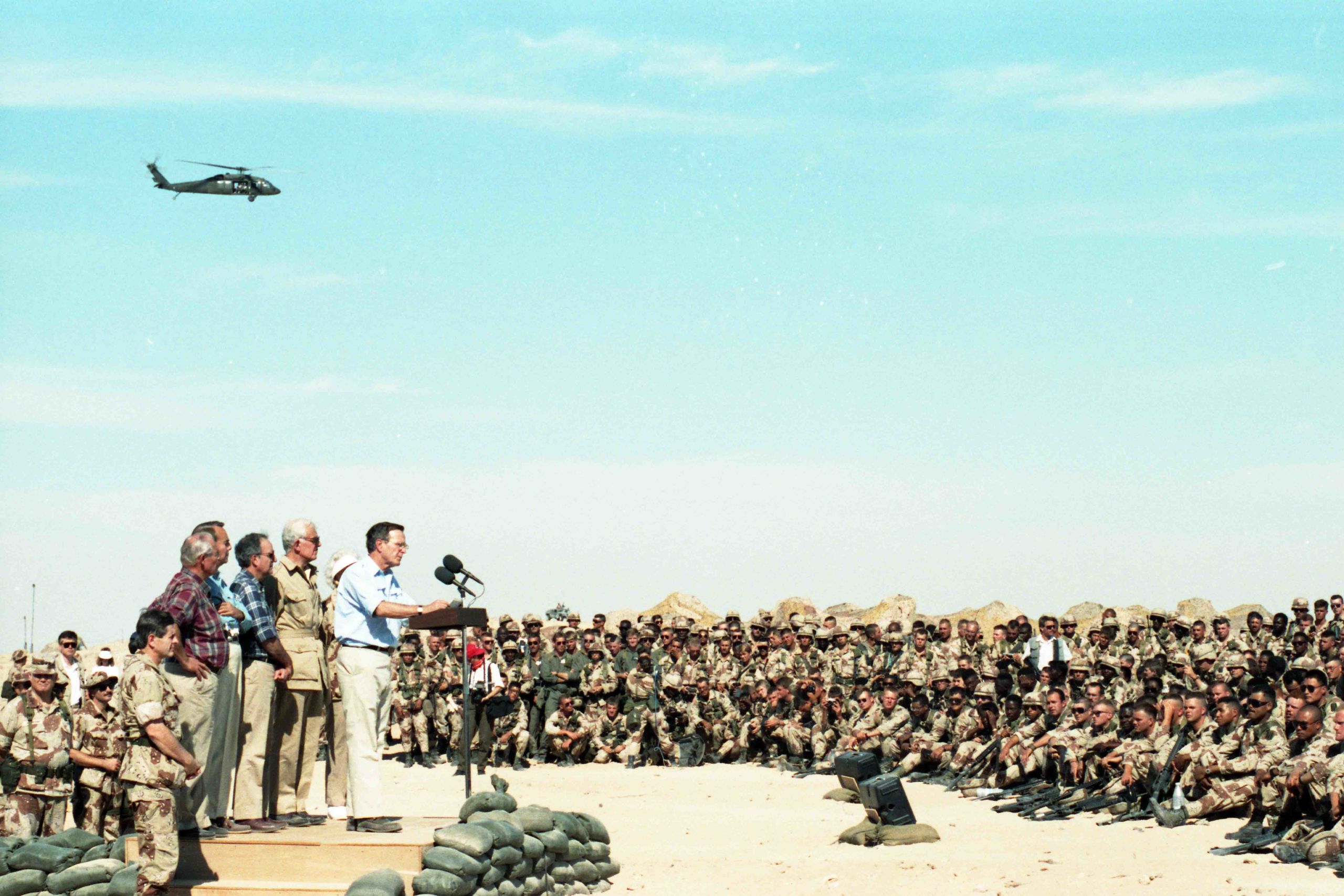
On Nov. 22, 1990, US President George H. W. Bush flew in to spend Thanksgiving with American forces in Saudi Arabia. (George H. W. Bush Presidential Library and Museum)
On Nov. 29, 1990, the UN Security Council passed the resolution that paved the way for a military response to Iraq’s aggression. Resolution 678 gave Saddam “one final opportunity, as a pause of goodwill,” to comply with Resolution 660, and a deadline of Jan. 15, 1991 was set.
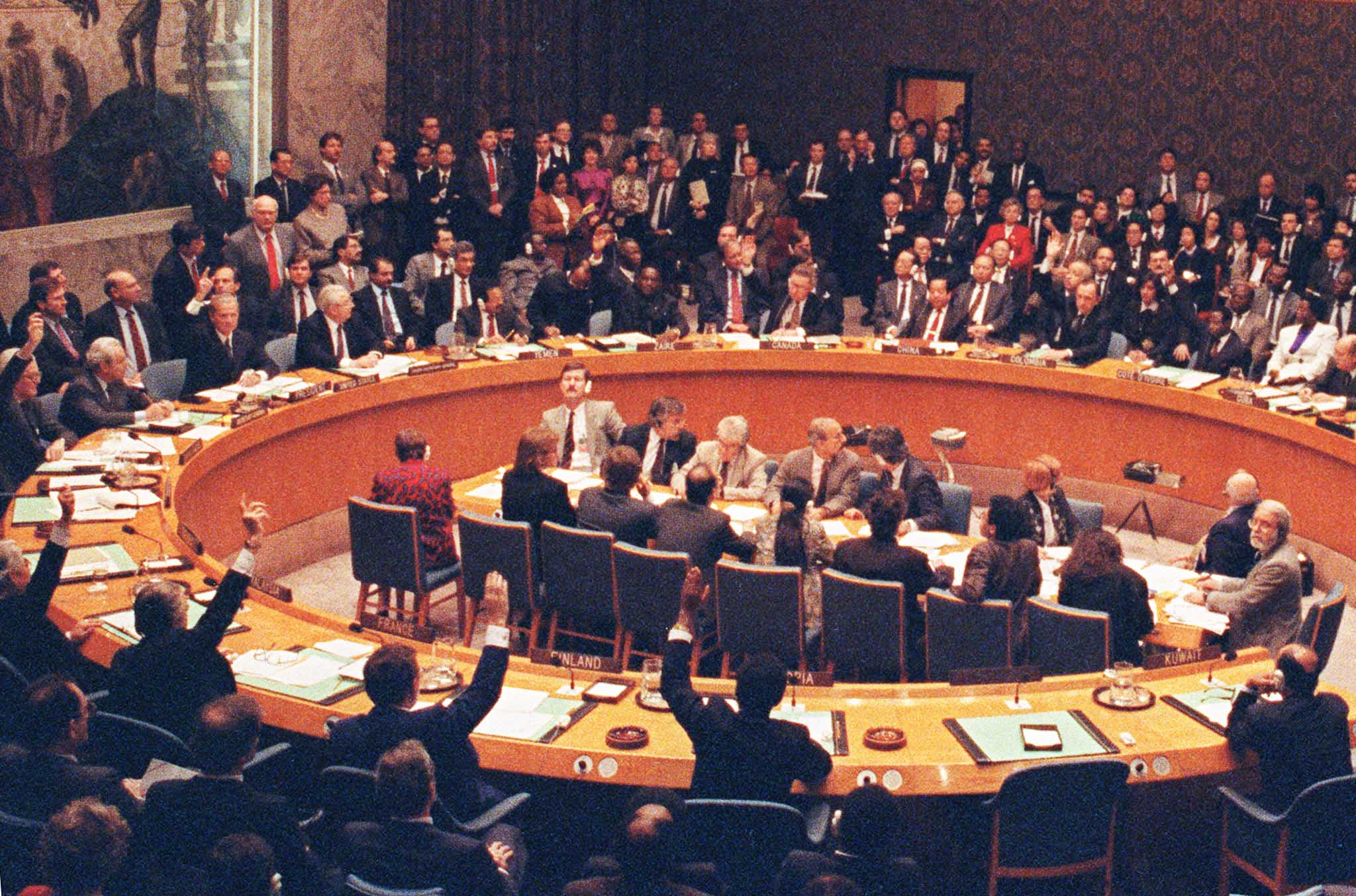
On Nov. 29, 1990, the UN Security Council voted to adopt Resolution 678, authorizing the use of military force if Iraq did not leave Kuwait by Jan. 15, 1991. (AFP)
On Nov. 29, 1990, the UN Security Council voted to adopt Resolution 678, authorizing the use of military force if Iraq did not leave Kuwait by Jan. 15, 1991. (AFP)
If Iraq had not left Kuwait by then, states cooperating with the government of Kuwait were authorized “to use all necessary means to uphold and implement Resolution 660 and all subsequent relevant resolutions and to restore international peace and security in the area.”
On Jan. 8, 1991, one week before the UN deadline, President Bush requested a congressional resolution authorizing the use of force. The resolution was passed by the House and the Senate on Jan. 12 and signed into law by the president on Jan. 14.
On Jan. 9, Cheney flew to Geneva to meet Tariq Aziz, Iraq’s deputy prime minister and foreign minister. There was little hope in the American camp that the meeting would change anything but, as Cheney later recalled, “it was very helpful here at home in the US … being able to say to the American people and to the press and the Congress, ‘Look guys, we tried everything and now we’ve got no option left but to use military force’.”
Desert Shield, the five-month build-up of three-quarters of a million US and Allied troops in the Gulf, was over. The Iraqis were about to reap the whirlwind that was Desert Storm.

The Arab News front page of Aug. 10, 1990 reports King Fahd’s denunciation of Iraq’s “most horrible aggression.”
The Arab News front page of Aug. 10, 1990 reports King Fahd’s denunciation of Iraq’s “most horrible aggression.”

Saudi Arabia’s King Fahd and Gen. Prince Khaled bin Sultan review troops of the Royal Saudi Landing Force in 1991. (Getty Images)
Saudi Arabia’s King Fahd and Gen. Prince Khaled bin Sultan review troops of the Royal Saudi Landing Force in 1991. (Getty Images)

Soldiers from the US 82nd Airborne Division, wearing chemical warfare suits and M-17A1 protective masks, walk around their camp trying to acclimate to the heat of the Saudi summer during Operation Desert Shield in 1990. (Getty Images)
Soldiers from the US 82nd Airborne Division, wearing chemical warfare suits and M-17A1 protective masks, walk around their camp trying to acclimate to the heat of the Saudi summer during Operation Desert Shield in 1990. (Getty Images)

On Nov. 22, 1990, US President George H. W. Bush flew in to spend Thanksgiving with American forces in Saudi Arabia. (George H. W. Bush Presidential Library and Museum)
On Nov. 22, 1990, US President George H. W. Bush flew in to spend Thanksgiving with American forces in Saudi Arabia. (George H. W. Bush Presidential Library and Museum)
Operation Desert Storm
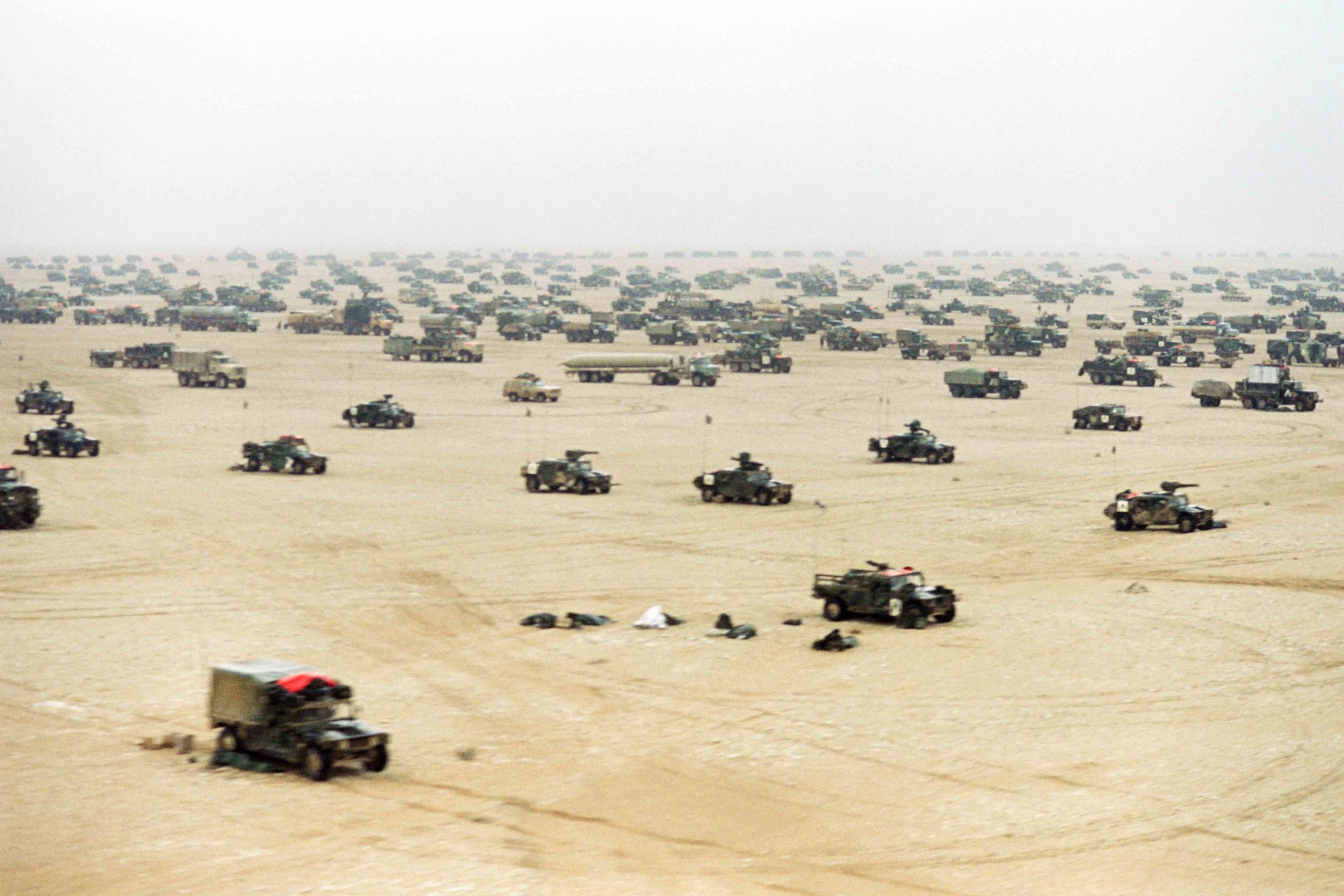
At 1:30 a.m. on Jan. 17, 1991, a Tomahawk cruise missile blasted off from the USS San Jacinto, part of the USS John F. Kennedy Carrier Battle Group sailing somewhere in the Red Sea off the coast of Saudi Arabia. Moments later and 1,500 kilometers to the east in the Arabian Gulf, the USS Bunker Hill launched another Tomahawk into the night sky.
The first shots had been fired in Operation Desert Storm, announcing the beginning of a staggeringly complex choreography of troops, machines and weapons.
Both Tomahawks would reach their targets in Baghdad at exactly 3 a.m. local time — H-Hour, in military terminology signifying the start of the aerial phase of Operation Desert Storm. Over the next 42 days, the Iraqi defenses and logistical networks were systematically destroyed as an overture to a ground war that would see Iraq ejected from Kuwait.
On day one, destruction rained down on command facilities, including more than 45 targets in Baghdad alone. Also targeted were the national electricity grid, telecommunications, air defense systems, airfields, nuclear, chemical and biological weapons research facilities, missile production and launch sites, ports, oil refining and distribution centers, railways and bridges. By dawn, air attacks had begun on Iraqi forces in Kuwait.
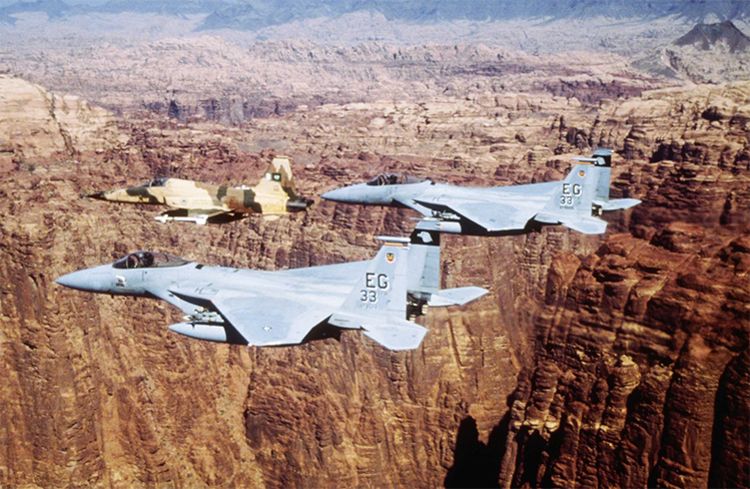
Two US Air Force F-15C Eagle fighters accompany a Royal Saudi Air Force F-5E Tiger II fighter during a mission in support of Operation Desert Storm. (Getty Images)
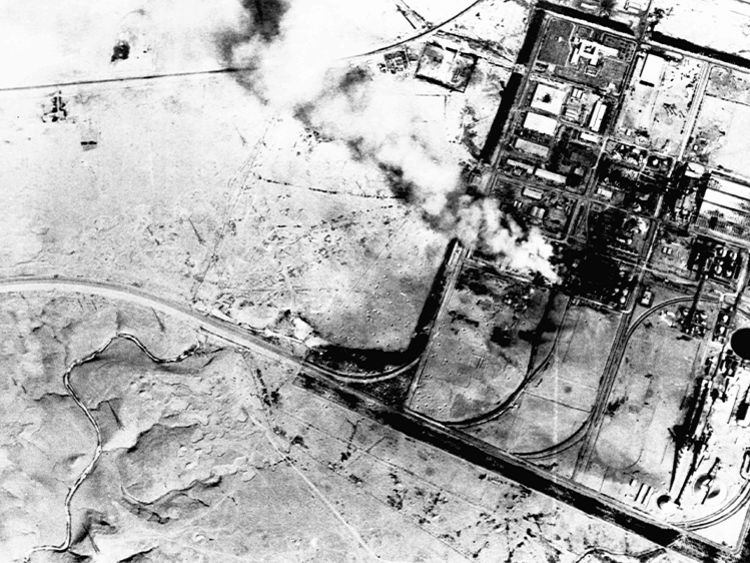
A photograph taken from a US fighter shows the damage to Iraq's Al-Qaim superphosphate fertilizer plant after an Allied bombing attack during Operation Desert Storm. (Getty Images)
In the first 24 hours, seven warships would launch 116 Tomahawk missiles at 16 targets in and around Baghdad, disrupting power supplies and crippling Iraqi command and control capabilities.
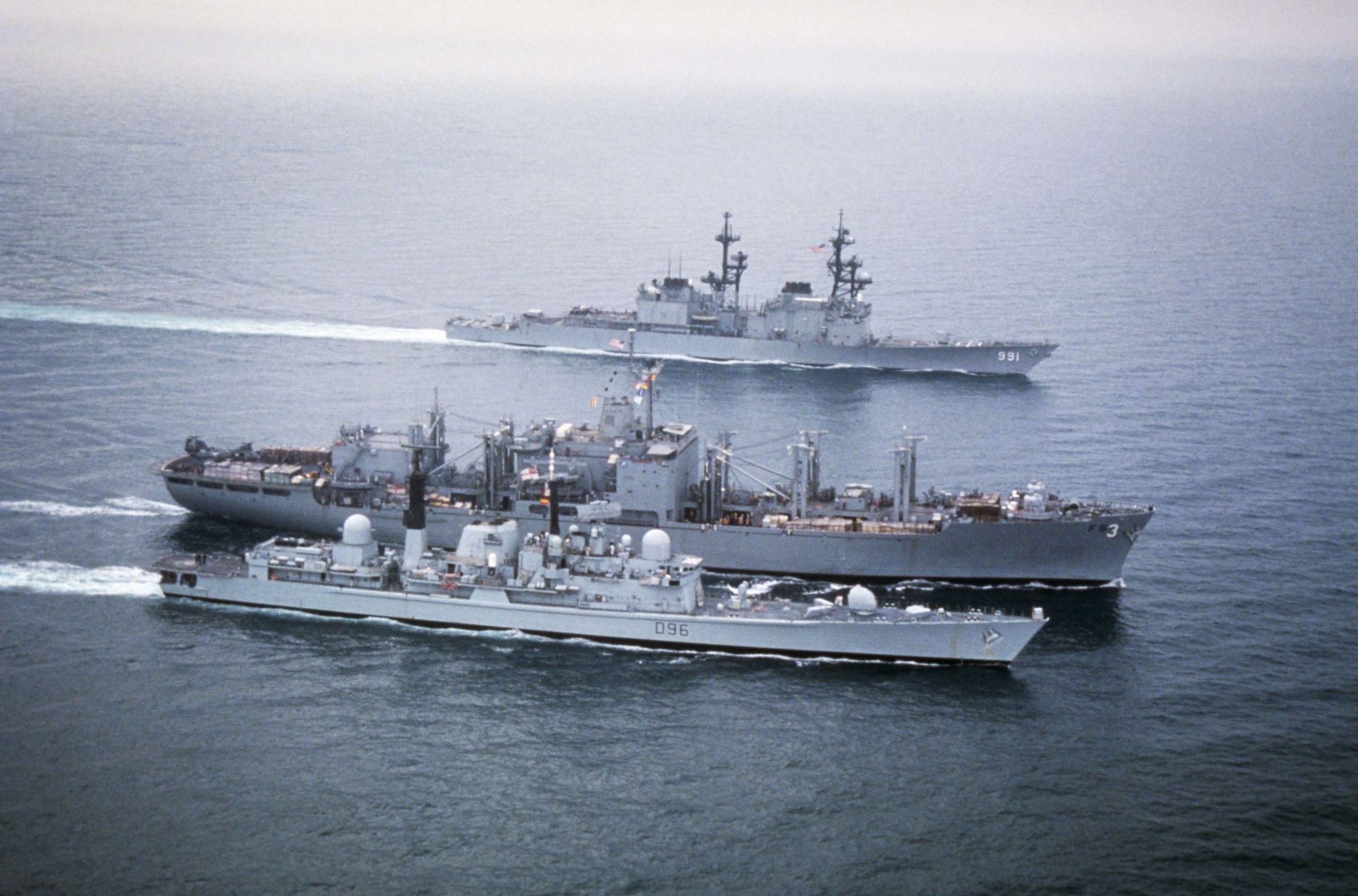
The British destroyer HMS Gloucester, in the foreground, takes on supplies from the combat stores ship USS Niagara Falls while under way in the Gulf during Operation Desert Storm. (Getty Images)
More than 11 hours before H-Hour, long-range B-52 Stratofortress bombers took off from Barksdale Air Force Base in Louisiana. Hours later, as they neared Iraqi airspace, they dropped 36 air-launched cruise missiles, programed to zero-in on military communication sites and other strategic targets.
That night alone, 700 combat aircraft, including bombers, fighters, attack helicopters and electronic-warfare aircraft, would enter Iraqi airspace.
One of the earliest series of strikes was carried out by nine US Army AH-64 attack helicopters from the 101st Airborne Division, which destroyed early-warning radar sites in southwest Iraq, opening up gaps in the defenses through which non-stealth aircraft could pass undetected.
Meanwhile, taking off from carriers in the Gulf and the Red Sea, US Navy and Marine aircraft headed for targets in the south of Iraq. In the west, 19 US Air Force F-15Es, passing through the gaps that had been blown in the Iraqi radar defenses, bore down on Scud missile sites.
In southeastern Iraq, multiple aircraft from coalition forces, including the British Royal Air Force, the Royal Saudi Air Force and the Kuwaiti Air Force, struck at airfields, port facilities, air defenses and other strategic targets.
Much of the Iraqi air force stayed on the ground, with aircraft and crews sheltering in hardened shelters, which proved no match for coalition bombs and missiles. Other aircraft were flown to safety in Iran, while some were parked near civilian neighborhoods or in the shadow of ancient archaeological sites, which had been declared off-limits to coalition aircraft.
By Jan. 27, Gen. Schwarzkopf, commander in chief, US Central Command, announced the Iraqi air force was “combat ineffective.”
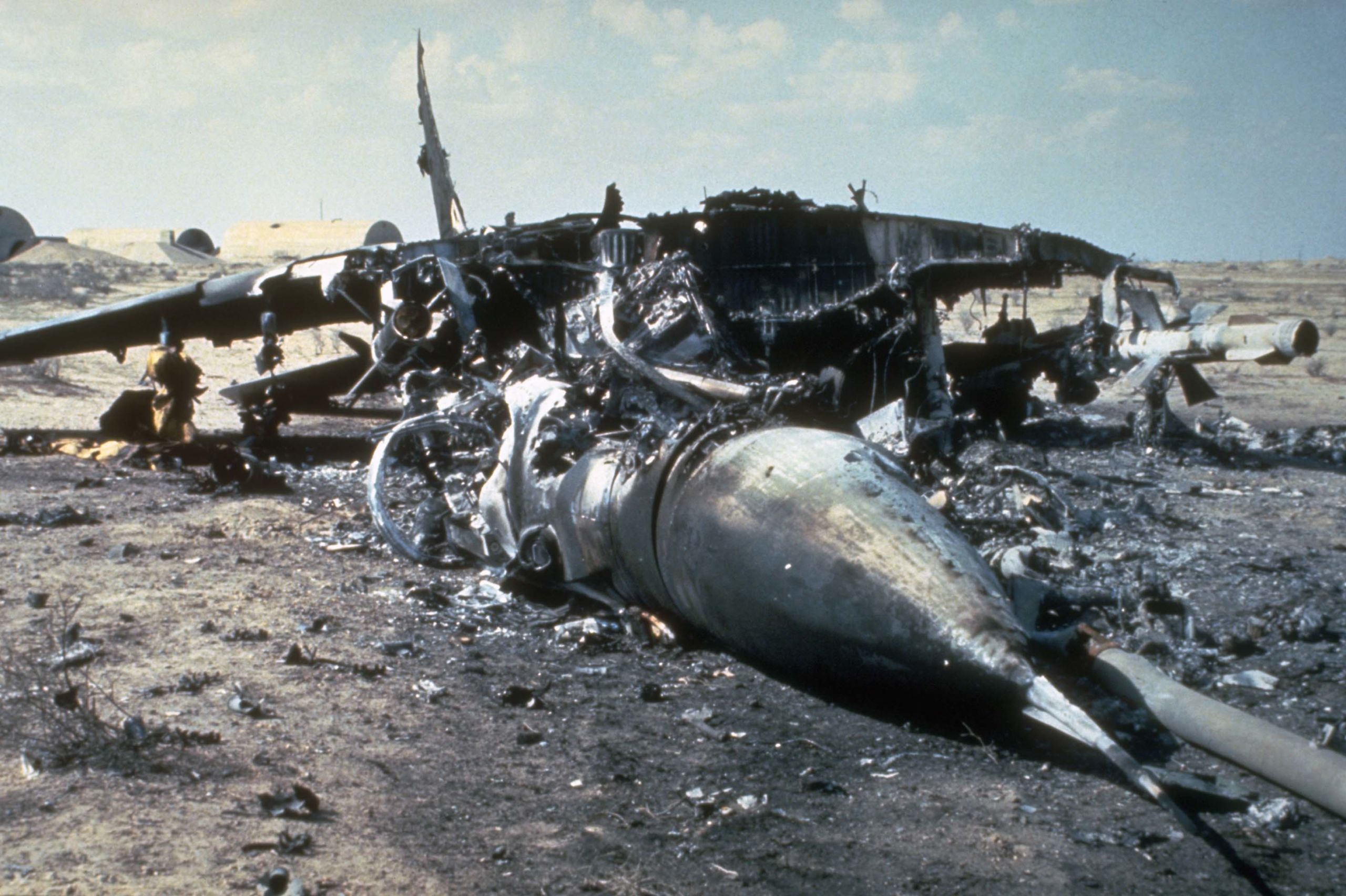
The ruins of an Iraqi MiG-25 aircraft destroyed by Allied forces during Operation Desert Storm. (Getty Images)
The ruins of an Iraqi MiG-25 aircraft destroyed by Allied forces during Operation Desert Storm. (Getty Images)
Inevitably, mistakes had been made — one in particular more terrible than most. On Feb. 13, two US F-117 stealth bombers destroyed what had been identified as a command-and-control bunker in Baghdad. In fact, it was a civilian air-raid shelter, and some 400 people were killed, including many children. By the end of the air phase, however, the combat effectiveness of the Iraqi forces in Kuwait had been reduced by about half.
Both before and throughout the air campaign, coalition commanders had feared a sudden thrust by Iraqi troops over the Saudi border. Saddam had had his chance in the days after the invasion of Kuwait, when coalition troops were extremely thin on the ground but, to the relief of the allies, he had failed to take it.
By day 12 of the aerial campaign, with Saudi Arabia now heavily defended, such an attack would be wholly irrational. And that, of course, was the moment Saddam chose to order his troops across the Saudi border in what would be Iraq’s only substantial ground offensive during the war.
Under cover of darkness on Jan. 29, several hundred Iraqi tanks and mechanized troops advanced along a 40-kilometer front stretching from the Saudi border town of Ras Al-Khafji on the Gulf to Al-Wafra. Undefended, Ras Al-Khafji, which had been evacuated immediately after the occupation of Kuwait because of its proximity to the border, was occupied by the Iraqis. But not for long.
As Saudi Arabian National Guard troops and tanks and US Marine Corps forces moved forward to stall the Iraqi advance, the coalition proceeded to give Saddam a costly lesson in the benefits of tactical air support.
The Iraqi forces, which had no air support, faced attacks from a steady stream of fixed-wing aircraft armed with conventional bombs and cluster bombs, while three Lockheed AC-130 gunships from the 1st Special Operations Wing out of Florida, firing cannons and Gatling-gun-style rapid-fire heavy machine guns, provided close fire support for the coalition troops.
“The combination of dogged resistance by the ground forces and the constant pounding from coalition air forces stopped the Iraqi advance,” the Pentagon later reported.
The following night, Saudi Arabian and Qatari armored elements launched a counterattack against the Iraqis and by midday on Jan. 31 “they had destroyed the remaining Iraqi forces in the town, taking several hundred prisoners of war.”
The Battle of Al-Khafji was over. It was never clear what Saddam had hoped to gain by it, but coalition planners thought it might have been born out of frustration after three weeks of an air war in which the Iraqis had done nothing but take casualties and fire Scud missiles, largely ineffectively, at targets in Saudi Arabia and Israel. Saddam might also have been hoping for hostages. Prisoners of war reported that a major objective of the assault had been to capture American troops.

Two US Air Force F-15C Eagle fighters accompany a Royal Saudi Air Force F-5E Tiger II fighter during a mission in support of Operation Desert Storm. (Getty Images)
Two US Air Force F-15C Eagle fighters accompany a Royal Saudi Air Force F-5E Tiger II fighter during a mission in support of Operation Desert Storm. (Getty Images)

A photograph taken from a US fighter shows the damage to Iraq's Al-Qaim superphosphate fertilizer plant after an Allied bombing attack during Operation Desert Storm. (Getty Images)
A photograph taken from a US fighter shows the damage to Iraq's Al-Qaim superphosphate fertilizer plant after an Allied bombing attack during Operation Desert Storm. (Getty Images)

The British destroyer HMS Gloucester, in the foreground, takes on supplies from the combat stores ship USS Niagara Falls while under way in the Gulf during Operation Desert Storm. (Getty Images)
The British destroyer HMS Gloucester, in the foreground, takes on supplies from the combat stores ship USS Niagara Falls while under way in the Gulf during Operation Desert Storm. (Getty Images)
In the end, though, in the Pentagon’s later assessment, “his disastrous defeat in that engagement foreshadowed his larger, ultimate defeat.” The battle “seemed to indicate a decline in the will of Iraqi soldiers while at the same time it provided a great boost in morale and confidence among coalition Arab forces.”
Nevertheless, the coalition expected to meet fierce resistance when its ground offensive began. The Iraqis had not been idle during the five months of occupation. By January, the number of troops in Kuwait had risen to about 500,000 and, according to the Pentagon’s post-war assessment, at least two “formidable” defensive belts had been set up along the border with Saudi Arabia.
These consisted of minefields and oil-filled fire trenches, covered by interlocking fields of fire from dug-in tanks, artillery and machine-gun nests. Behind these defenses, the Iraqis had amassed “strong, mobile, heavily armored counterattack forces, comprised of the best elements of the Iraqi army,” units of the Republican Guard positioned to hit back at any breakthrough by attackers.
Along the coast, similar defenses had been constructed in anticipation of an amphibious assault from the sea, with land and sea seeded with mines, while the Iraqis had fortified many of the high-rise buildings on the seafront, “turning them into multi-tier fortresses.”
A great deal of work had also gone into logistics. The Iraqis had built “an impressive system of roads … so numerous that it was not feasible to destroy all of them,” and had buried communications lines and supply depots. Underground command posts had also been constructed, and by early January coalition planners estimated that in Kuwait and along the border with Iraq, the enemy had gathered enough supplies to last for more than a month of sustained fighting.
They would not be needed. The fourth-largest army in the world would flee Kuwait within hours of the start of the ground phase of Operation Desert Storm.
“G-Day” was Sunday, Feb. 24, 1991. The official Pentagon account paints a picture of an enemy massed in large numbers behind seemingly formidable defenses but led incompetently and overwhelmed by the forces arrayed against them.
Frontline Iraqi units offered “sporadic … sometimes stiff, resistance,” but either withdrew, surrendered or were bypassed. Generally, morale was low. Prisoners of war and deserters who had fled into Saudi Arabia before the offensive described an Iraqi army in disarray, hampered by “lack of food and water and poor sanitation” and by breakdowns in communications and intelligence.
All along the front, which extended 500 kilometers inland across the desert from the Gulf coast, the coalition advance proceeded to plan. On the left flank, mainly US, British and French infantry, airborne and armored divisions surged deep into Iraq before turning east, cutting off the retreat of large numbers of Iraqi forces in Kuwait.
Massed in the center on the Saudi border with Kuwait were elements of the Arab forces. Saudi and Egyptian armored and mechanized infantry divisions, Syrian infantry and special forces and Kuwaiti brigades “encountered Iraqi fire trenches, minefields, barriers and harassing fires as they crossed the border in their zone,” but quickly overwhelmed the Iraqi defenses.
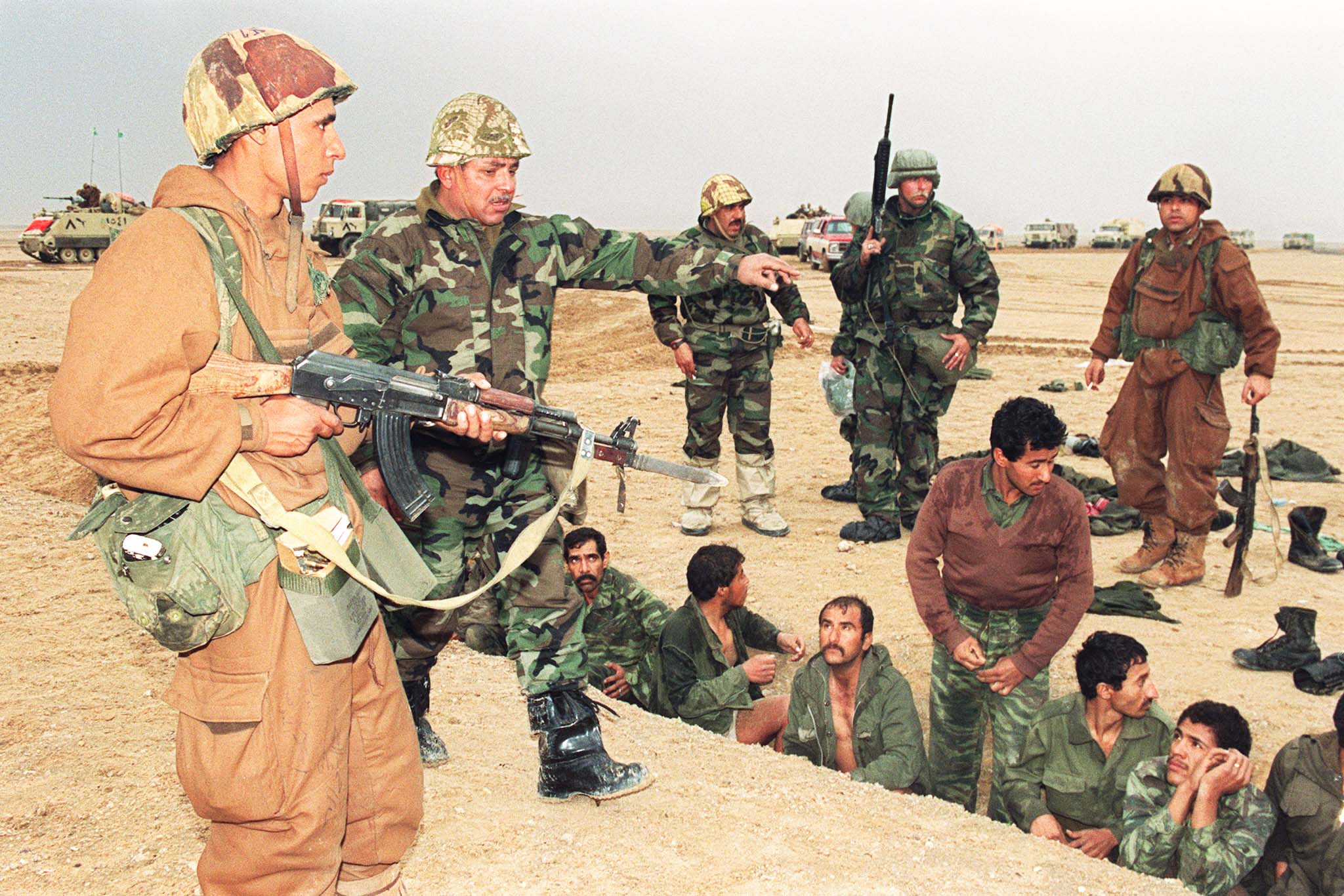
Egyptian and US soldiers guard Iraqi prisoners of war in the Kuwait desert on Feb. 25, 1991. Iraqi forces reportedly suffered from low morale. (AFP)
On their right flank were the US Marines, who advanced toward Kuwait City through the Al-Wafra oil field, but the honor of entering and liberating Kuwait City fell to the Arab forces on the far right of the coalition line, under the command of Prince Khaled.
Under him were three task forces representing all six GCC states. By the end of the first day, this Joint Forces Command East, supported as it advanced by fire from the 16-inch guns of the US Iowa-class battleships USS Missouri and USS Wisconsin in the Gulf, had taken many prisoners and achieved all of its day-one objectives.
On Day 2, the ground offensive continued its forward momentum all along the line. Two Iraqi divisions put up a brief fight against the Arab forces advancing along the coast toward Kuwait City but by the end of the day were assessed as “combat ineffective” and all coalition units in the sector had reached their objectives.
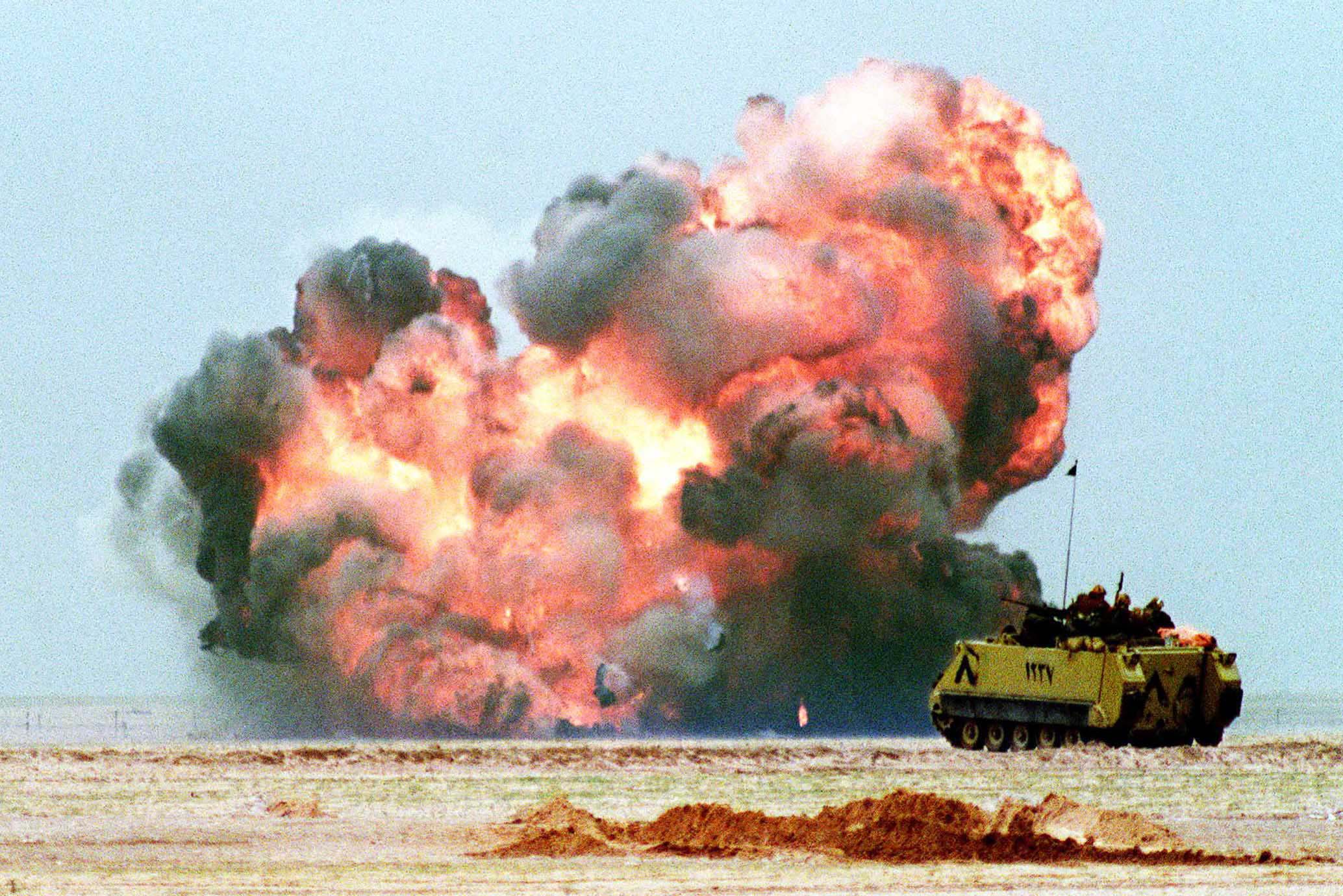
An Egyptian light armored vehicle explodes after driving over an Iraqi mine on Feb. 25, 1991, the second day of Desert Storm. (AFP)
But a dark shadow would fall over the otherwise successful events of Feb. 25. Before the war, Iraq’s much-feared Scud missile capability had caused much anxiety among the coalition planners. In the event, however, the Scuds failed to make much more than a psychological impact. The large Russian-made missiles, which were packed with high explosives but controlled by a relatively primitive gyroscopic guidance system, were not very accurate.
It was Saddam’s hope that by firing Scuds at Israeli cities, he would provoke Israel into going to war, creating a dilemma for the Arab states aligned against him and fracturing the US-led coalition. It almost worked.
Cheney later recalled that “when the Scuds started to fly, the Israelis really wanted to retaliate, which was normal.” Israel asked the US to negotiate access for its aircraft through Saudi Arabian, Jordanian and Syrian airspace, “which of course, we refused to do.”
Iraq began firing the Scuds at targets in Israel and Saudi Arabia shortly after the start of the coalition air attacks on Jan. 17. The 42 missiles that hit Israel, mainly in the Tel Aviv area, killed just two people, although 200 more were injured.
About 46 Scuds were fired at Saudi Arabia, 18 of which targeted Riyadh. Many of the missiles flew wide of their targets or were shot down by the US Patriot anti-missile system. But on Jan. 25, one missile struck a Saudi Ministry of Interior building in Riyadh, killing one person and injuring dozens more.

Egyptian and US soldiers guard Iraqi prisoners of war in the Kuwait desert on Feb. 25, 1991. Iraqi forces reportedly suffered from low morale. (AFP)
Egyptian and US soldiers guard Iraqi prisoners of war in the Kuwait desert on Feb. 25, 1991. Iraqi forces reportedly suffered from low morale. (AFP)

An Egyptian light armored vehicle explodes after driving over an Iraqi mine on Feb. 25, 1991, the second day of Desert Storm. (AFP)
An Egyptian light armored vehicle explodes after driving over an Iraqi mine on Feb. 25, 1991, the second day of Desert Storm. (AFP)
And on Feb. 25, another had devastating consequences. Just after 8:30 p.m., a Scud aimed at Dhahran Airfield struck a warehouse in the suburb of Alkhobar being used as a barracks for US troops. Twenty-eight Americans died and 260 more were injured, many of whom were treated in nearby Saudi hospitals. This single attack accounted for a third of all US casualties during the entire war.
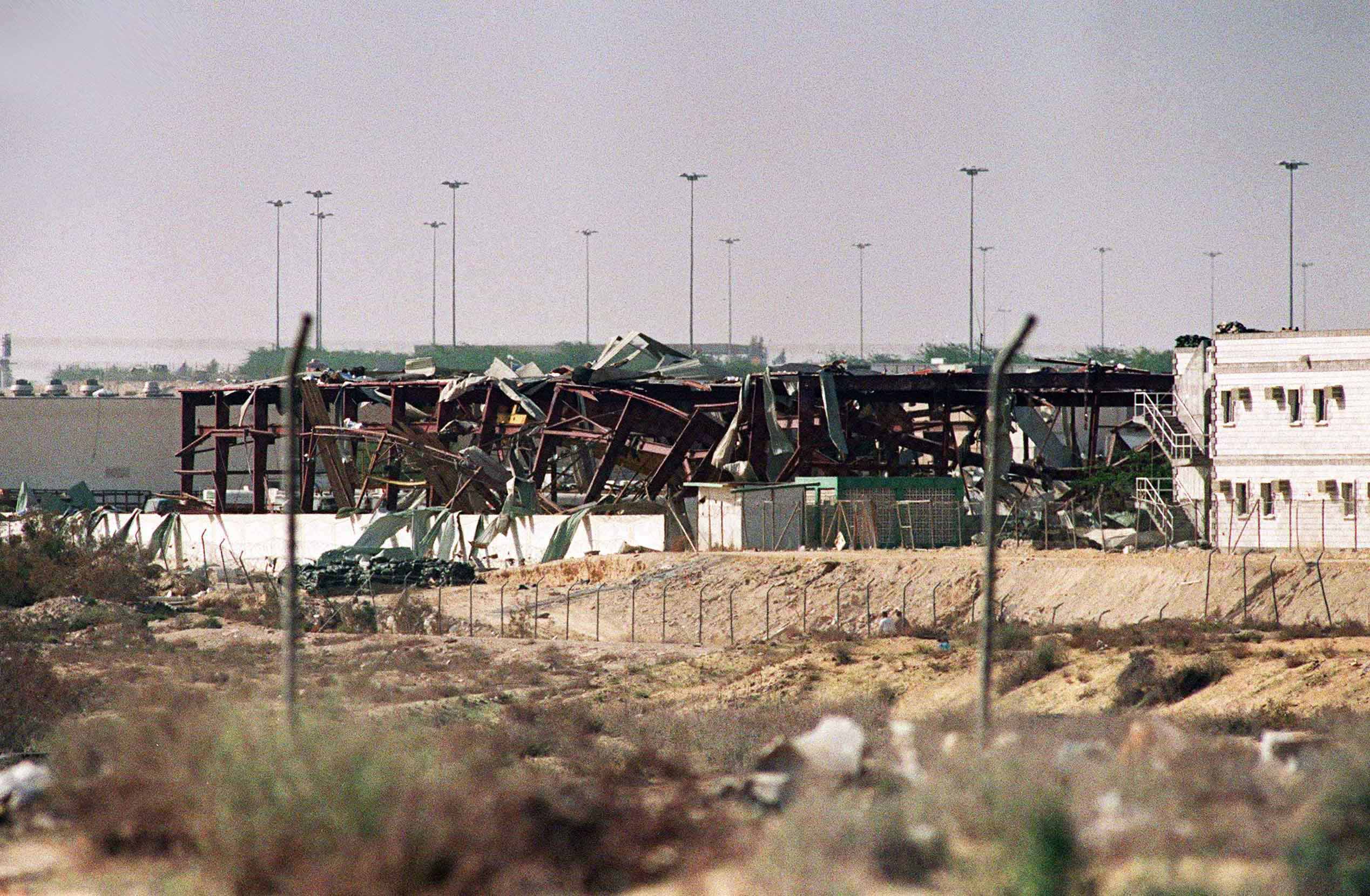
An Iraqi Scud missile hit a building housing US troops in Alkhobar, Saudi Arabia, on Feb. 25, 1991, killing 28 Americans – a third of all US casualties during the war. (AFP)
For Saddam, the strike was a last vicious gesture. By the end of that day, Baghdad Radio reported that the defeated dictator had ordered his forces to withdraw from Kuwait. The following day, Feb. 26, a mass exodus of Iraqi troops from the east of the combat zone began.
As Iraqi units routed by the Marines and the Arab forces fell back on Kuwait City, the Pentagon later reported, individual units “became intermingled and disordered.” Throughout the morning, “military and commandeered civilian vehicles of every description, loaded with Iraqi soldiers and goods looted from Kuwait, clogged the main four-lane highway north from Kuwait City.”
This was Highway 80, the road that runs between Basra and Kuwait City, which would soon become known to the world as “The Highway of Death.”
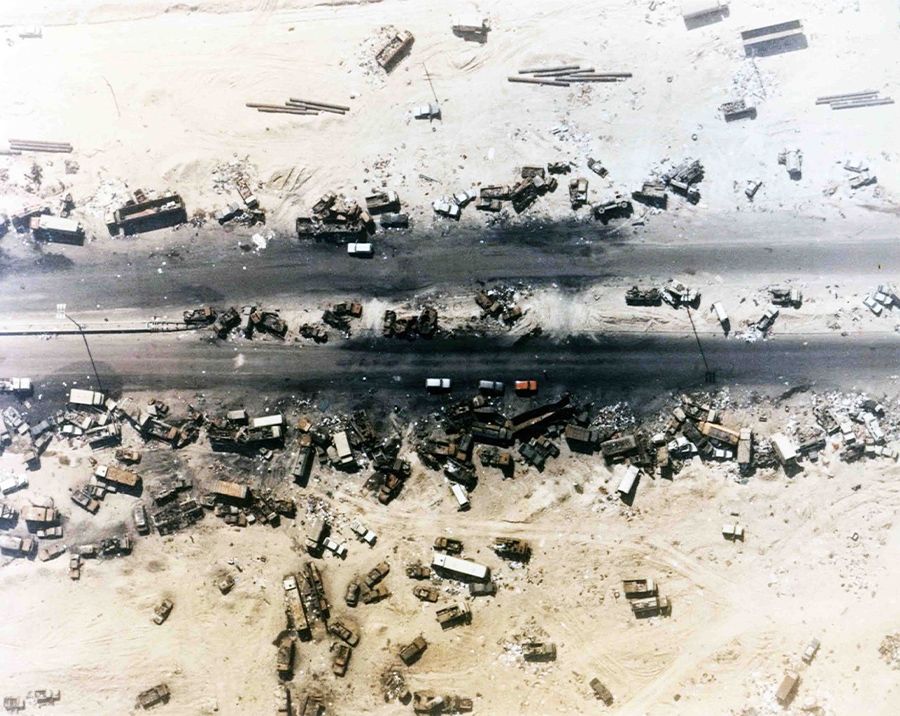
Highway 80, the road that runs between Basra and Kuwait City, became known as the Highway of Death after US aircraft repeatedly attacked the retreating Iraqi forces. (Getty Images)
Highway 80, the road that runs between Basra and Kuwait City, became known as the Highway of Death after US aircraft repeatedly attacked the retreating Iraqi forces. (Getty Images)
To prevent the retreating troops from reorganizing and mounting an effective defense in Iraq, they were hit repeatedly by coalition aircraft. It was a phase of the battle that would later be criticized, but Gen. Schwarzkopf had no sympathy.
He later recalled: “We bombed the highway because there was a great deal of military equipment on that highway and I had given orders that I wanted every piece of Iraqi equipment that we possibly could destroyed, because … that was equipment that would not be around for them to use later on.
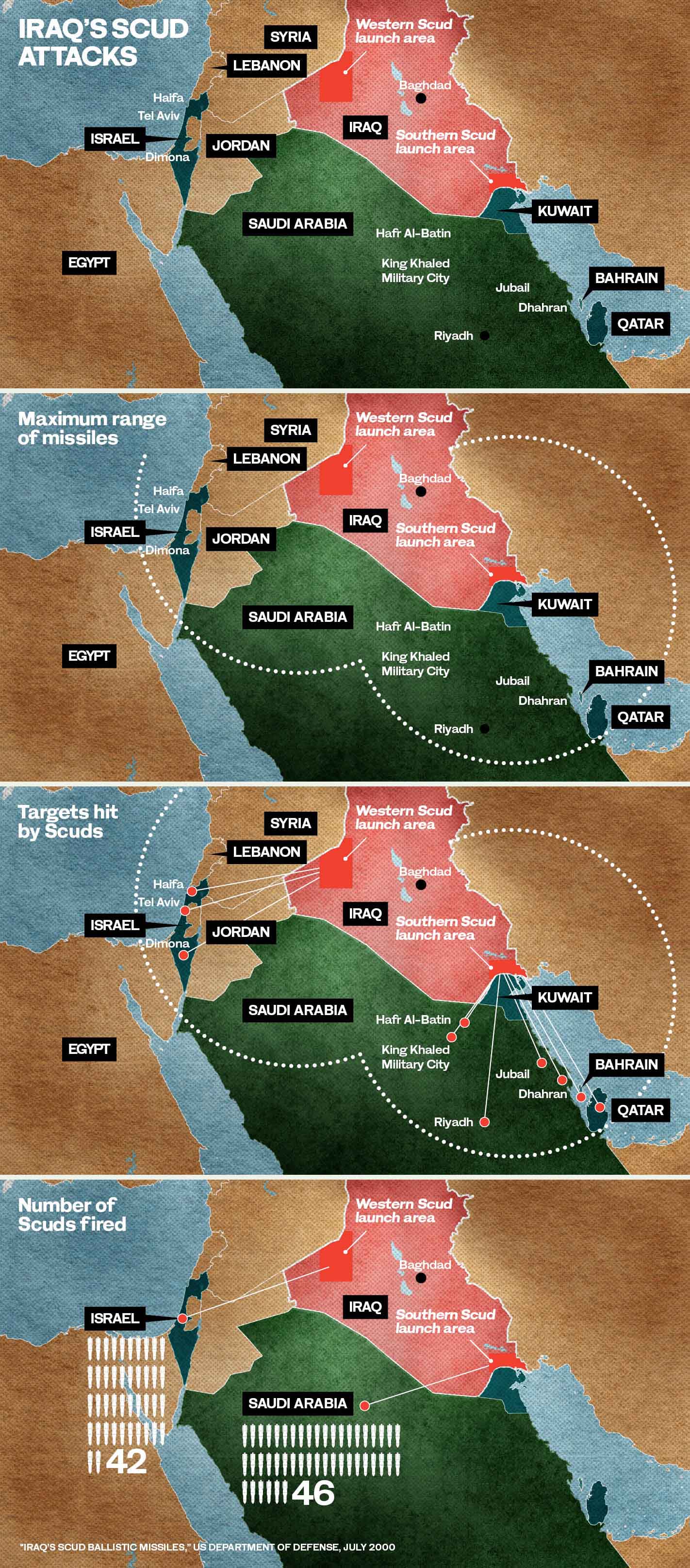
“Secondly, the people that were running away from Kuwait were the people that had been inflicting the atrocities on the City of Kuwait … this was not a bunch of innocent people just trying to make their way back across the border to Iraq. This was a bunch of rapists, murderers and thugs who had raped and pillaged downtown Kuwait City and now were trying to get out of the country before they were caught.”
Elsewhere, Iraqis were surrendering in their droves, and by sunset on day three of the ground assault, Feb. 26, coalition forces had pushed hundreds of kilometers into Iraq, destroyed or rendered ineffective 26 of 43 Iraqi divisions, forced the whole army into retreat and captured more than 30,000 prisoners.
By the end of the day, coalition forces on the left flank and in the center, which had first raced north and then swung east as far as the Euphrates River, had completely cut off and encircled Saddam’s forces in southern Iraq and Kuwait.
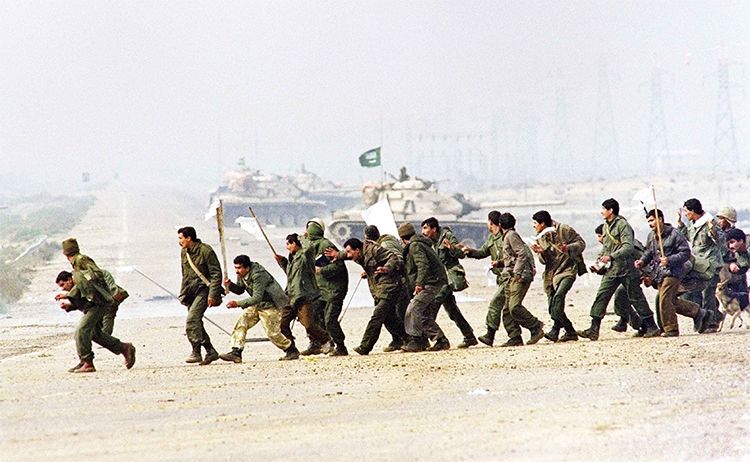
Iraqi soldiers carrying white flags surrender under the watchful eyes of a Saudi armored unit in Kuwait City on Feb. 25, 1991. (AFP)
Back in Kuwait, the Arab troops of Joint Forces Command North had achieved all its objectives, bar one. As night closed in, Task Force Khaled turned east toward Kuwait City, supported by the Egyptians and the Syrians. On their right flank, Joint Forces Command East was well ahead of schedule and had been “so successful,” reported the Pentagon, “that its western boundary was changed twice and it was given four additional objectives.”
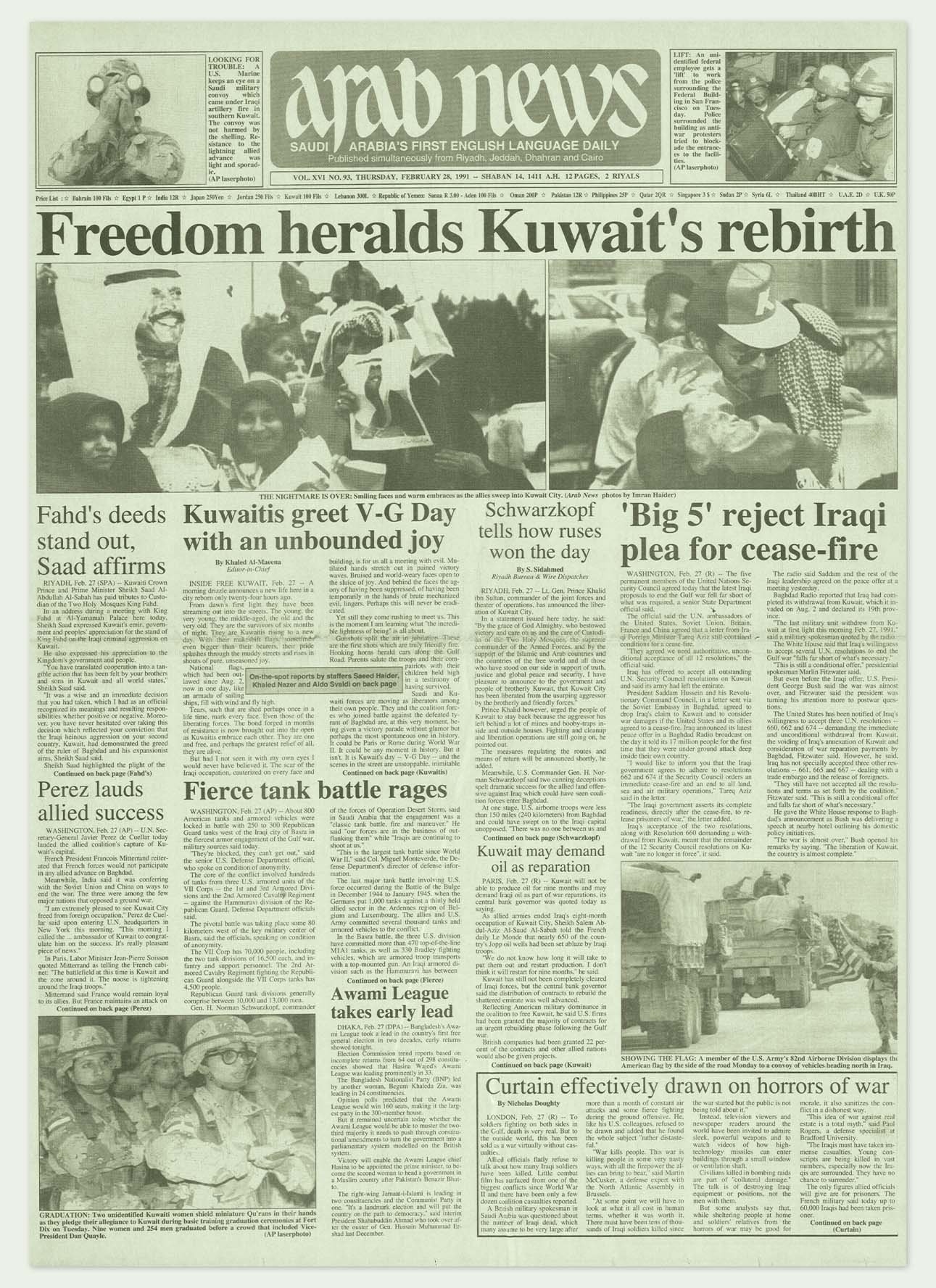
With the placeline "Inside Free Kuwait," Khaled Almaeena wrote in the Feb. 28 edition: "A morning drizzle announces a new life here in a city reborn only twenty-four hours ago."
By day’s end, “preparations were made for a pan-Islamic force to enter Kuwait City” on the following day. In the early hours of Feb. 27, a dozen Marines from the 2nd Force Reconnaissance Company infiltrated into Kuwait City, where they were “greeted by jubilant Kuwaitis and American flags waving from buildings, despite sporadic fire from Iraqi stragglers.” Arab forces received an equally rapturous welcome as they entered the west and east of the city, while Saudi special forces secured the Saudi Arabian embassy.
The ground assault ended at 8 a.m. on Thursday, Feb. 28. After just 100 hours of combat, during which Allied armored divisions had punched more than 400 kilometers into enemy territory, the much-vaunted Iraqi army lay in ruins — 3,847 tanks, 1,450 armored personnel carriers and 2,917 artillery pieces had been destroyed or captured, only five of its 43 combat divisions remained capable of offensive operations and 86,000 prisoners had been taken.
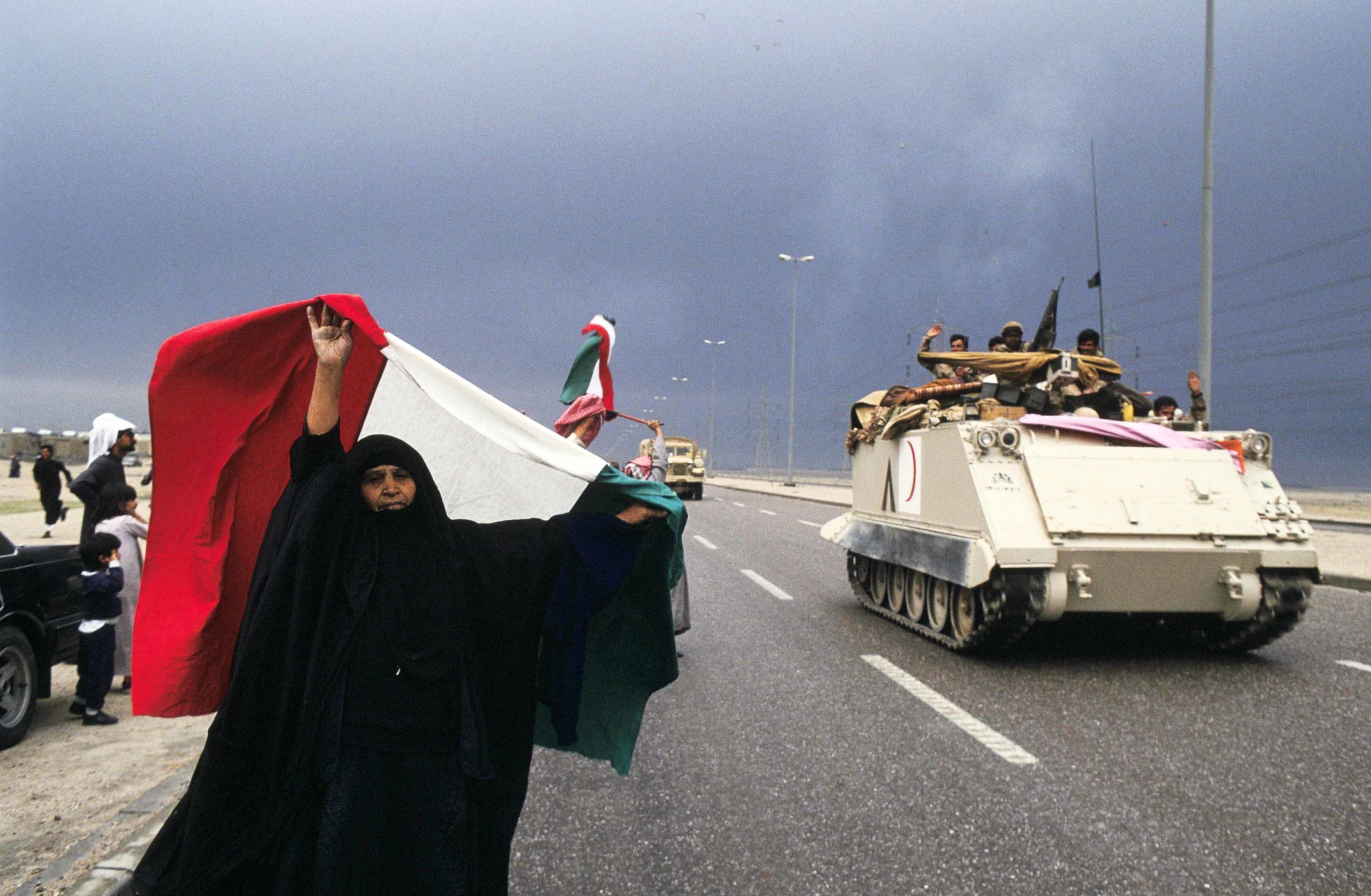
Kuwaitis rejoice as Allied forces liberate Kuwait City on Feb. 27, 1991. (Getty Images)
Iraq’s military and civilians paid a high price for their leader’s recklessness. The war had cost the lives of as many as 200,000 Iraqi soldiers and, by some estimates, a similar number of Iraqi civilians. By comparison, coalition losses were slight — a total of just 250 killed as a direct result of enemy action.
Coalition forces, in the words of the Pentagon assessment, had won “one of the fastest and most complete victories in military history.” In the process they had achieved all three of their objectives: “To eject Iraqi armed forces from Kuwait, destroy the Republican Guard in the Kuwait Theater of Operations, and help restore the legitimate government of Kuwait.”
But Saddam Hussein remained in power.
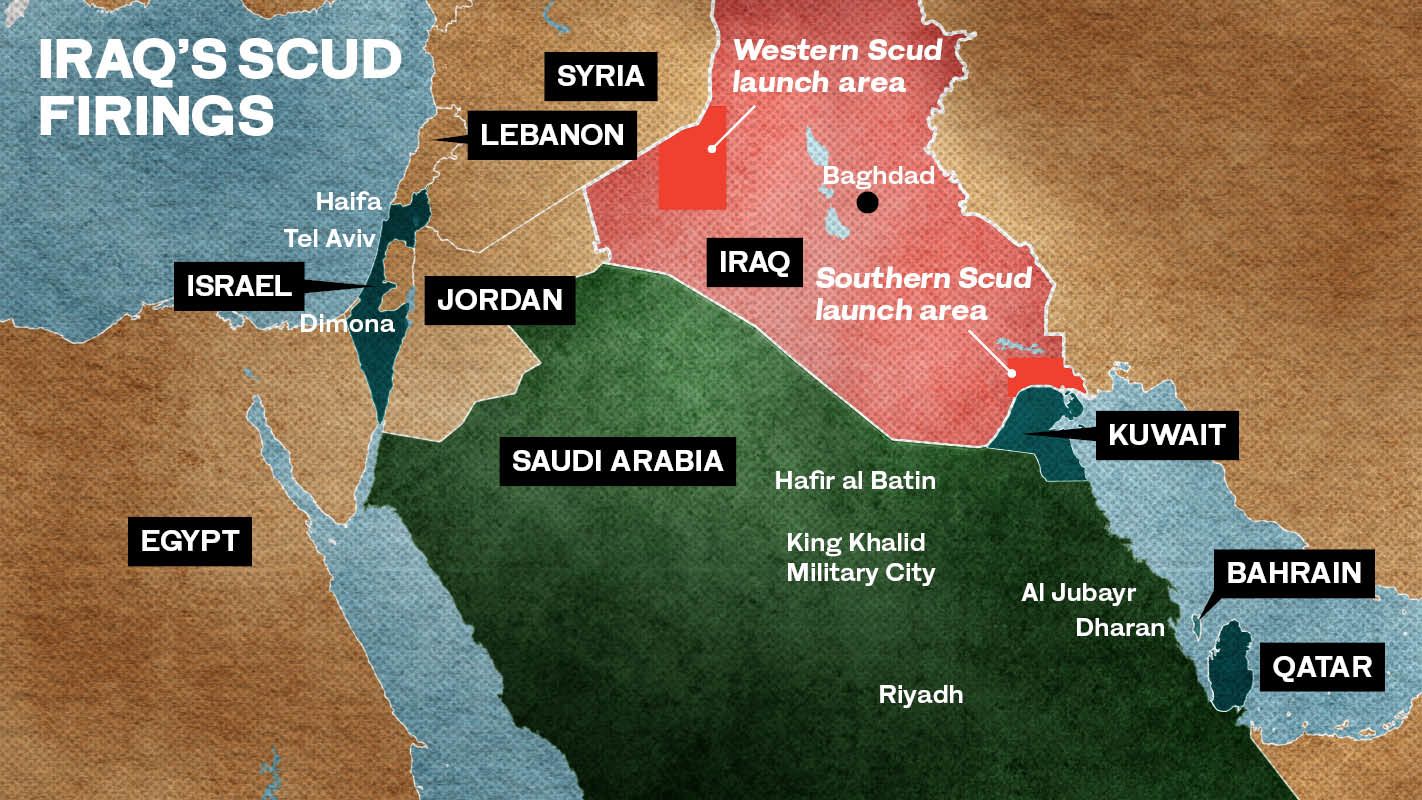
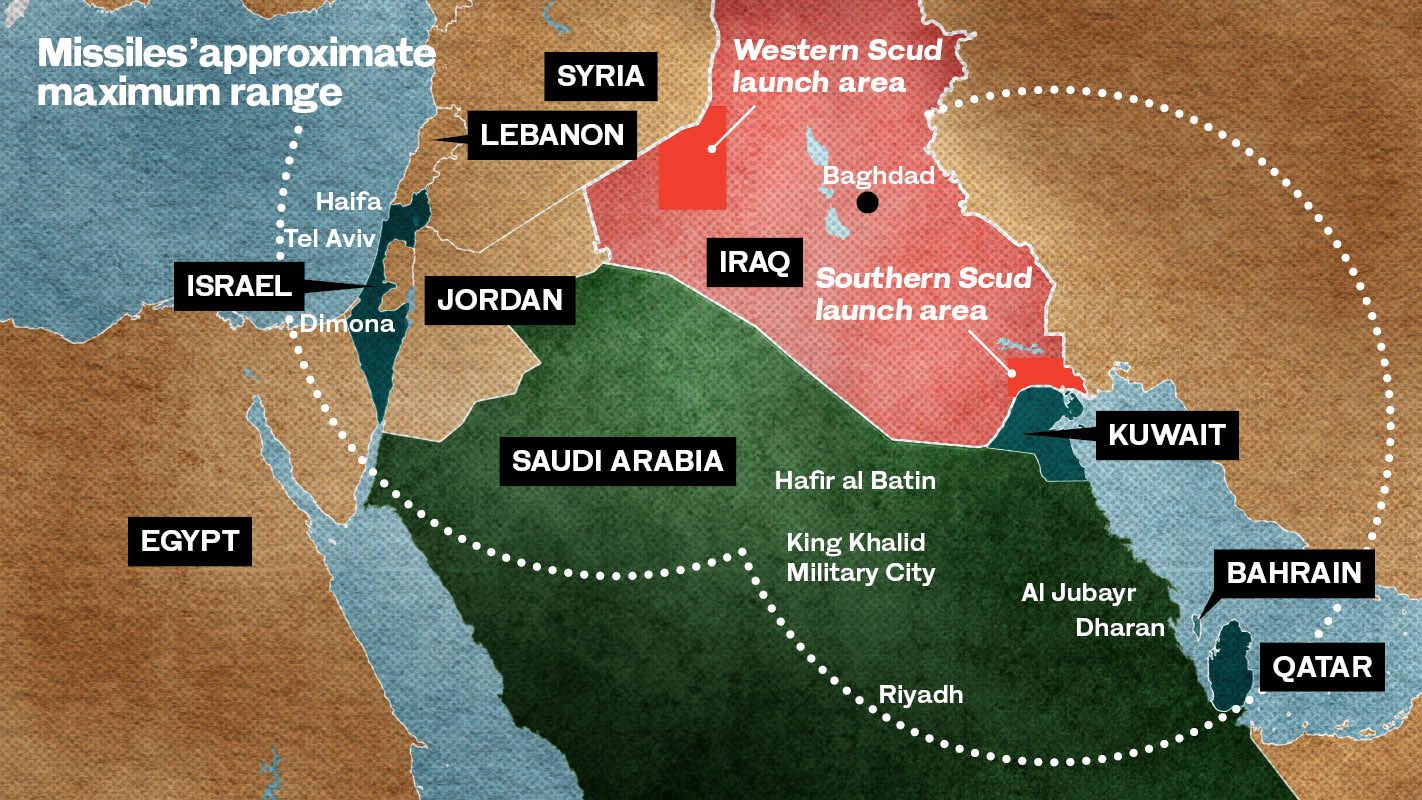
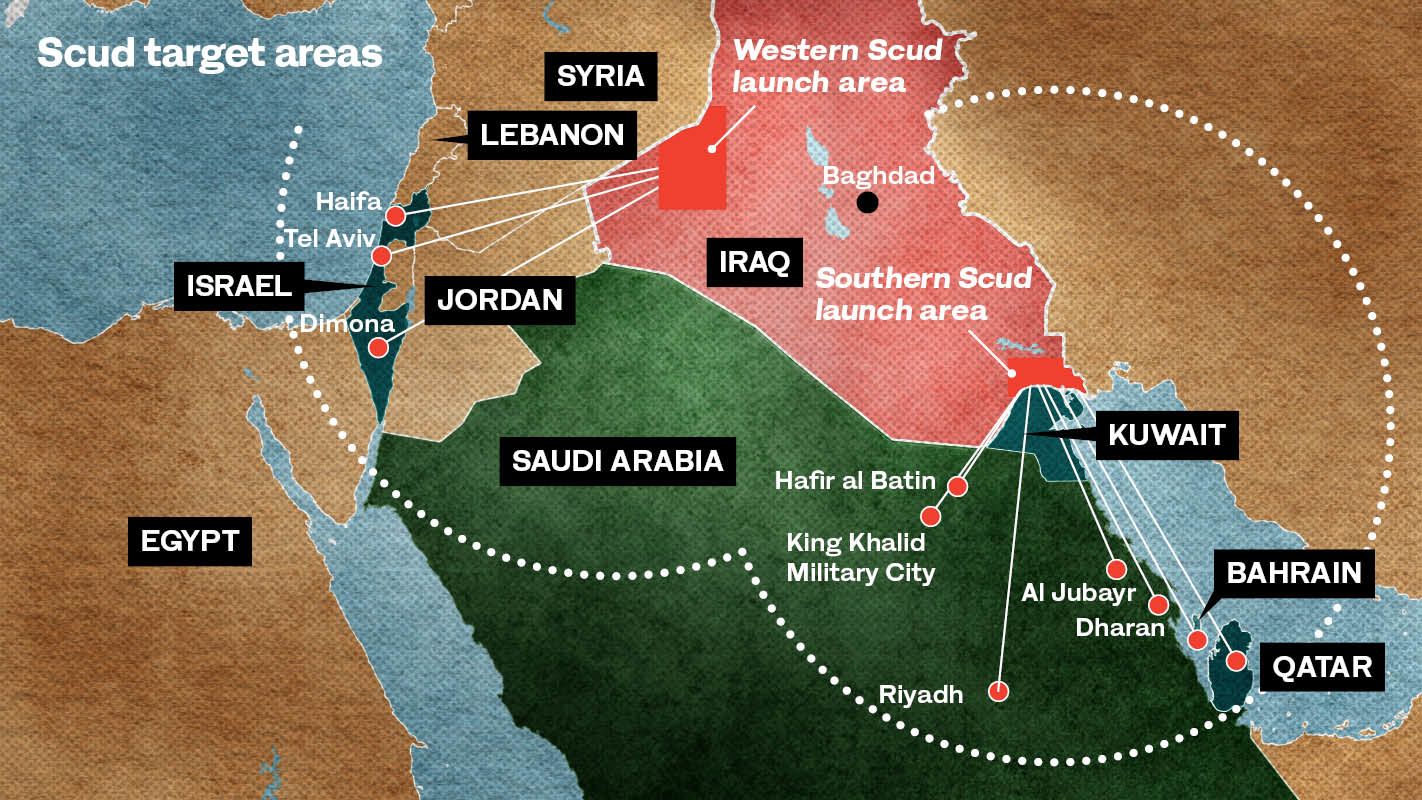
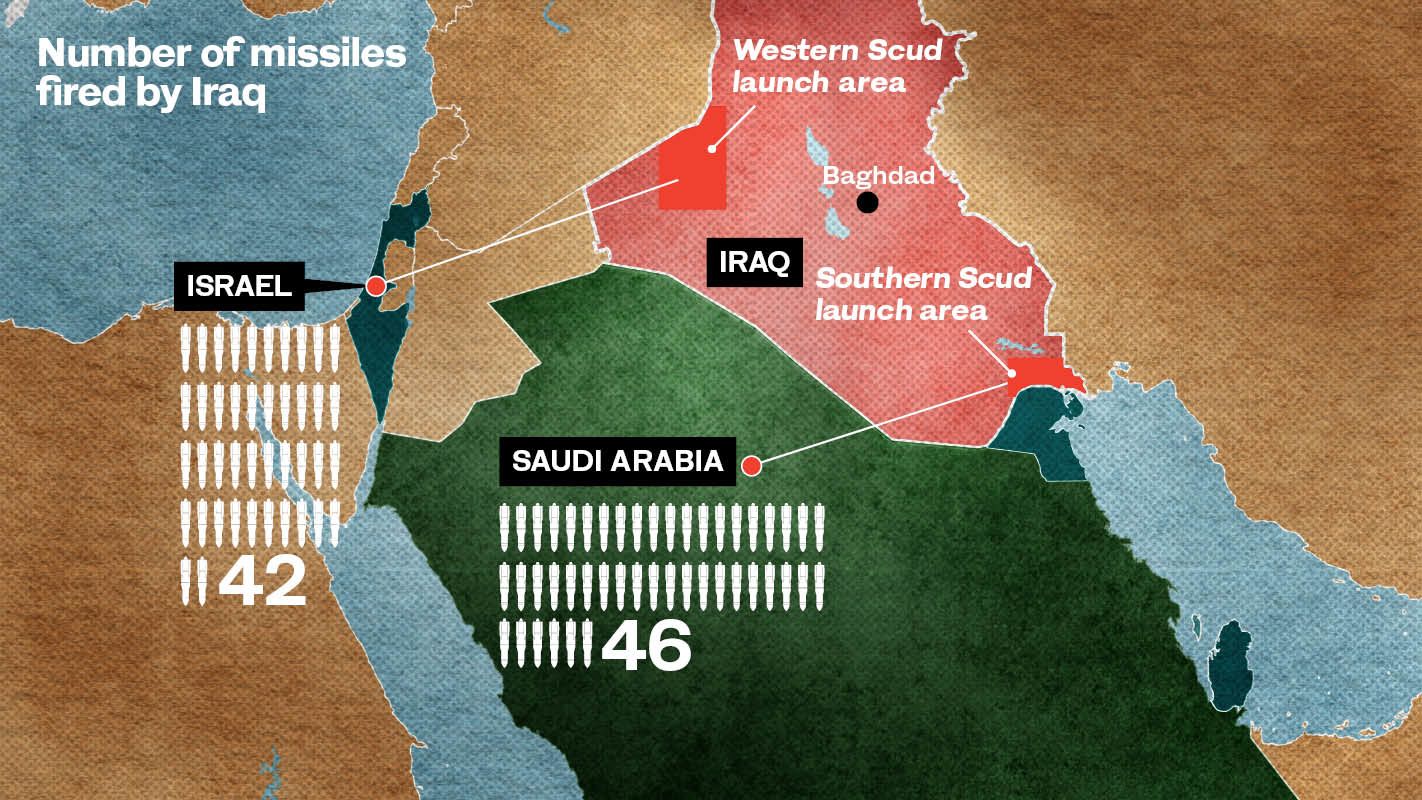

An Iraqi Scud missile hit a building housing US troops in Alkhobar, Saudi Arabia, on Feb. 25, 1991, killing 28 Americans – a third of all US casualties during the war. (AFP)
An Iraqi Scud missile hit a building housing US troops in Alkhobar, Saudi Arabia, on Feb. 25, 1991, killing 28 Americans – a third of all US casualties during the war. (AFP)

Iraqi soldiers carrying white flags surrender under the watchful eyes of a Saudi armored unit in Kuwait City on Feb. 25, 1991. (AFP)
Iraqi soldiers carrying white flags surrender under the watchful eyes of a Saudi armored unit in Kuwait City on Feb. 25, 1991. (AFP)

With the placeline "Inside Free Kuwait," Khaled Almaeena wrote in the Feb. 28 edition: "A morning drizzle announces a new life here in a city reborn only twenty-four hours ago."
With the placeline "Inside Free Kuwait," Khaled Almaeena wrote in the Feb. 28 edition: "A morning drizzle announces a new life here in a city reborn only twenty-four hours ago."

Kuwaitis rejoice as Allied forces liberate Kuwait City on Feb. 27, 1991. (Getty Images)
Kuwaitis rejoice as Allied forces liberate Kuwait City on Feb. 27, 1991. (Getty Images)
The aftermath
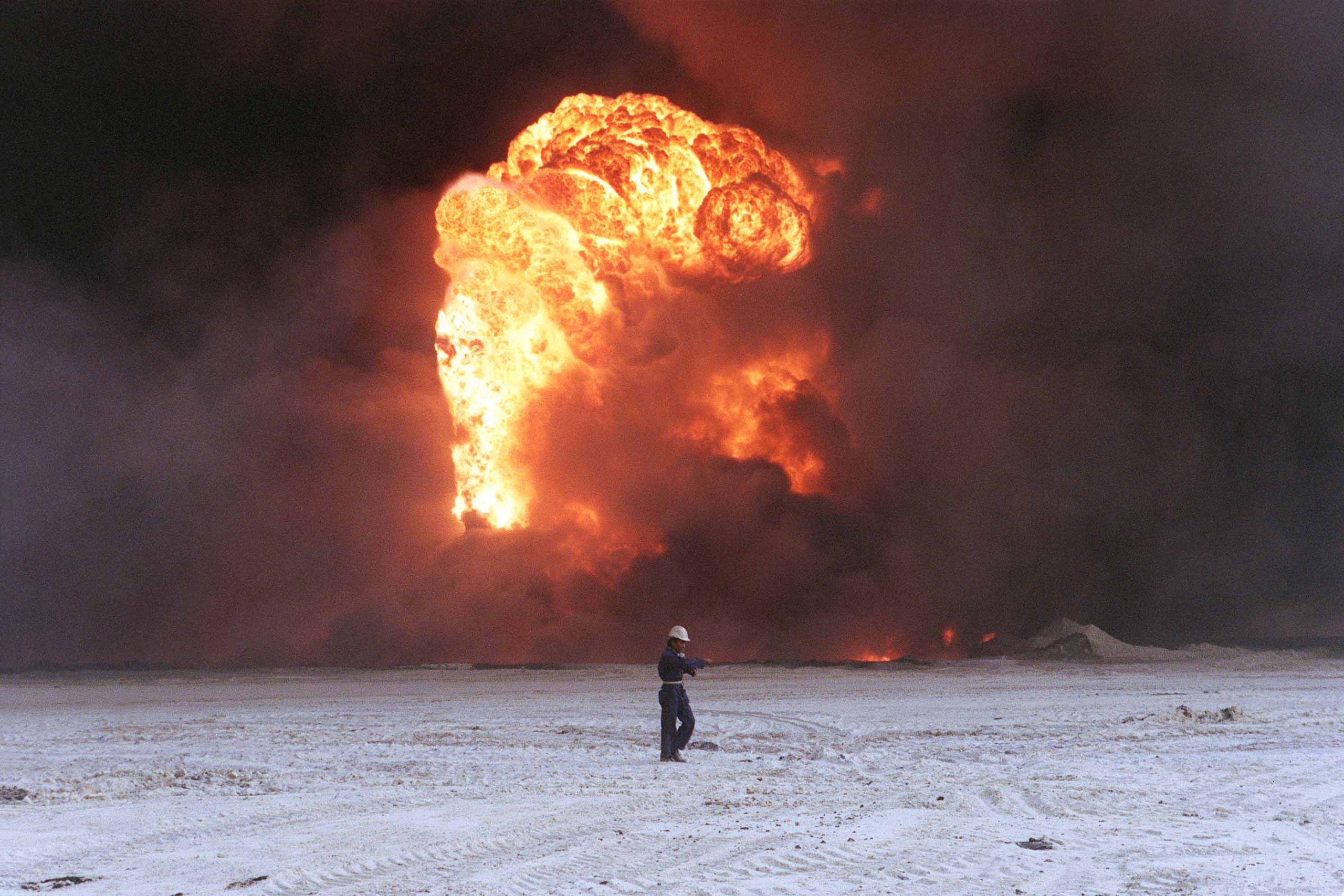
One of the most familiar images of the First Gulf War was captured by the NASA Space Shuttle Atlantis in April 1991. The startling photograph, taken five weeks after the war’s end, shows plumes of thick black smoke streaming into the skies around Kuwait City from the oil wells that had been set alight by the retreating Iraqi army. The plumes extended for hundreds of kilometers and reached as high as five kilometers into the atmosphere.
Saddam Hussein’s vindictive act of environmental terrorism damaged over 900 Kuwaiti wells, with 608 set on fire and 42 left gushing. The 156 million barrels of crude oil released into the desert formed a series of vast lakes, many of which took years to be absorbed into the ground. Shortly after the start of the air war on Jan. 17, 1991, Iraqi soldiers released an estimated 11 million barrels of oil into the Gulf, a spill 20 times larger than that from the Exxon Valdez, the tanker that had run aground in Alaska’s Prince William Sound in March 1989.
On Jan. 25, as the coalition air assault intensified, Iraq again began pouring Kuwaiti oil into the Gulf. This continued until Jan. 27, when coalition aircraft targeted pumping stations and pipework, shutting off the flow. Over 1,200 kilometers of Kuwaiti and Saudi Arabian beaches were polluted, devastating wildlife, including migratory birds and turtles. It took an international team of firefighters eight months to extinguish the fires.
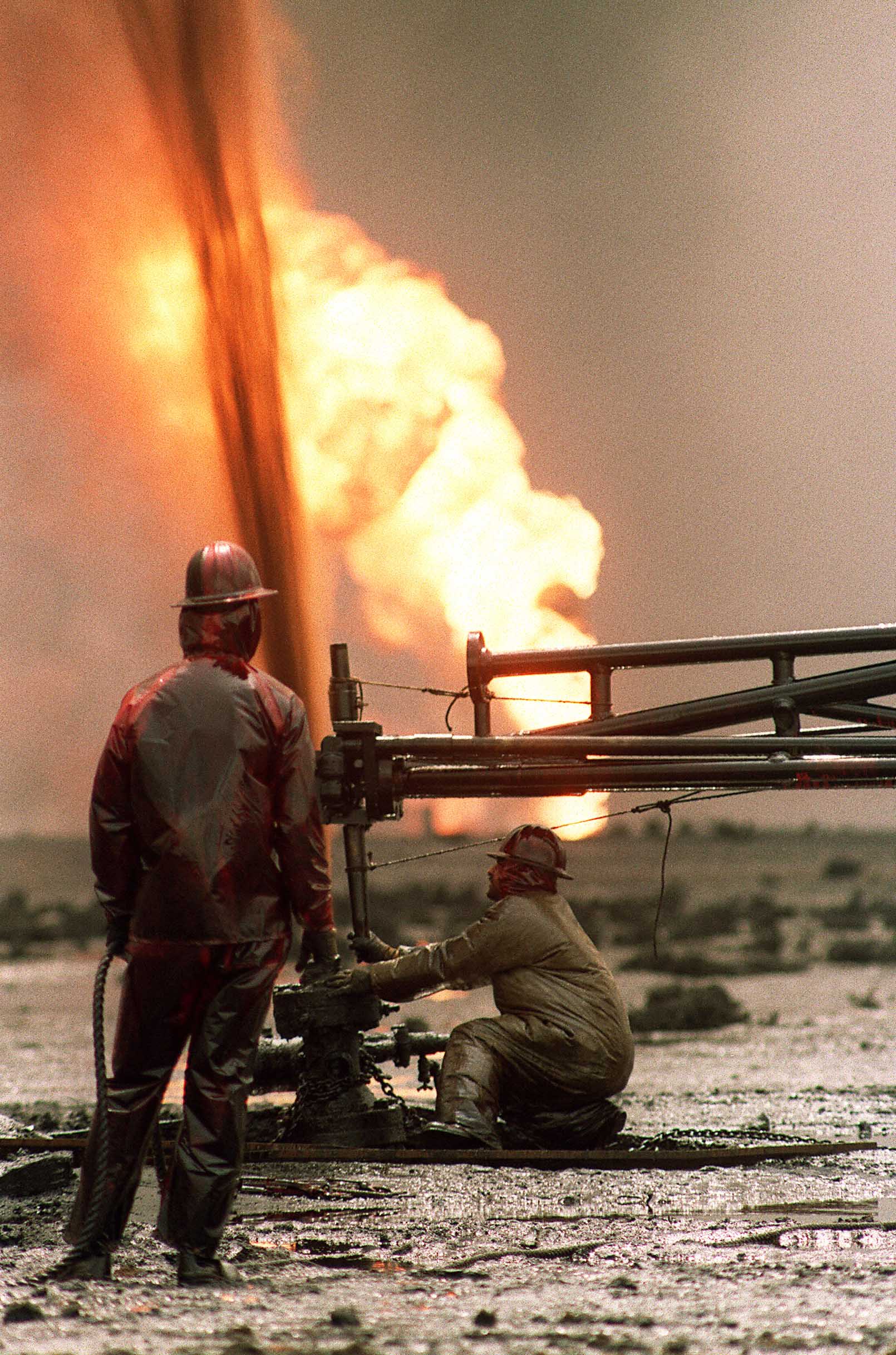
Members of the Red Adair firefighting crew work on a blown-out well damaged by retreating Iraqi soldiers in Al-Ahmadi oil field in southern Kuwait on March 30, 1991. (AFP)
Members of the Red Adair firefighting crew work on a blown-out well damaged by retreating Iraqi soldiers in Al-Ahmadi oil field in southern Kuwait on March 30, 1991. (AFP)
Lost oil was not the only material cost of the war to Kuwait, which was also stripped of some of its heritage. The invading army was joined by staff from Iraq’s Department of Antiquities, who proceeded systematically to loot the Kuwait National Museum, selecting items for shipping back to Baghdad. Among the items stolen were 3,000 pieces from the Sabah Collection of Islamic Art, an Islamic art and history library of 3,000 books and 40,000 items from the museum’s archaeological collection. The entire National Museum Library, consisting of about 20,000 books, was also looted.
Much of the material would be returned to Kuwait in September and October 1991, after the UN formed a new agency, the UN Return of Property, to oversee the return of material looted from Kuwait, but not everything was recovered.
And as bad as Saddam’s vindictive acts of vandalism and wholesale looting were, they were the least of the consequences of the First Gulf War, the geopolitical ramifications of which continue to overshadow the region today.
It is, of course, easy to point to the war as the cause of myriad catastrophes that have beset the Middle East ever since, including the rise of Osama bin Laden and Al-Qaeda, the 9/11 attacks on the US in 2001, the 2003 invasion of Iraq and the emergence of Daesh.
Former Arab News Editor in Chief Khaled Almaeena, who had been in Baghdad for the 17th Arab Summit just two months before the invasion of Kuwait, believes that “most of the Arab world’s issues today are a direct result of Saddam’s aggression.
“If Hussein had not invaded Kuwait, there would very likely have been no Al-Qaeda, no Daesh. The Kuwaiti invasion was the ultimate moment for those who wished to see Arabs violently disagreeing with, and actually fighting, each other.”
For Prince Khaled, there was no doubt the conflict affected inter-Arab relations negatively. “Hussein’s violation of what one might call the unwritten Arab code, his cannibalistic assault on one of his own, snapped a central Arab bond that I fear will take years to mend,” he wrote in 1993 in the RUSI journal.
This, added the general, was “unfortunate, because the future of the Gulf and the Middle East is littered with problems, and we do not need any more.”
It is, said Renad Mansour, head of the Iraq Initiative project at the London-based international affairs think tank Chatham House, impossible to know how the world might have been different today had Saddam been ousted in 1991, rather than in 2003, following the 9/11 attacks on America.
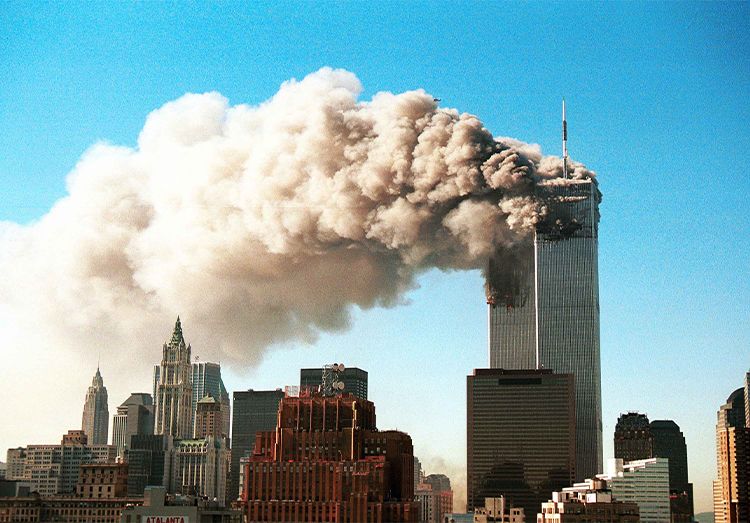
The First Gulf War has been blamed for triggering a chain of catastrophies, including Al-Qaeda's attacks on America on Sept. 11, 2001. (Getty Images)
But one of the problems with the US intervention in Iraq in 2003 was “the lack of depth in strategy and the lack of an endgame — this idea of ‘shock and awe,’ the idea that you could quickly change a state.”
The de-Ba’athification of Iraq “removed not only Hussein’s inner circle but also the top layers of the civil service of the whole country,” and this, Mansour said, “was one of the biggest strategic mistakes that could have been made by the Americans and their allies.”
Without an alternative plan in place for rebuilding the country, the resultant chaos was inevitable.
“It’s hard to know what would have happened if Bush Sr. had removed Hussein in 1991 but had maintained [the apparatus of] the state. But perhaps Iraq would not have gone off on the same trajectory it followed after 2003.”
Writing in the Los Angeles Times five years after the 1991 war, James Baker, President Bush’s former secretary of state, said the Americans had had no intention of toppling Saddam Hussein. One reason for halting the advance into Iraq when they did, rather than pressing on to Baghdad, was that “the United States and its coalition allies, including the Arab state members, uniformly believed that Saddam would not survive a military defeat of the magnitude that the coalition inflicted upon him.”
All of the political and war aims upon which the US had built the coalition had been achieved. Pressing on, added Baker, would have resulted in loss of life on a scale unacceptable to the US public and government. Iraqi soldiers and civilians “could be expected to resist an enemy seizure of their own country with a ferocity not previously demonstrated on the battlefield in Kuwait.”
Even if Saddam had been captured, America could have been faced with a lengthy occupation and insurrection. “Going beyond our mandate from the UN Security Council could have made an Arab nationalist hero out of Hussein,” concluded Baker. “Suddenly, an international coalition’s war to liberate Kuwait from a universally condemned invasion would have been transformed into a war of US imperialism in the view of the ‘Arab Street’ throughout the region.”
After 9/11, such concerns had been swept aside. For many in the administration of President George W. Bush, Iraq represented unfinished business that had been started by his father back in 1991.
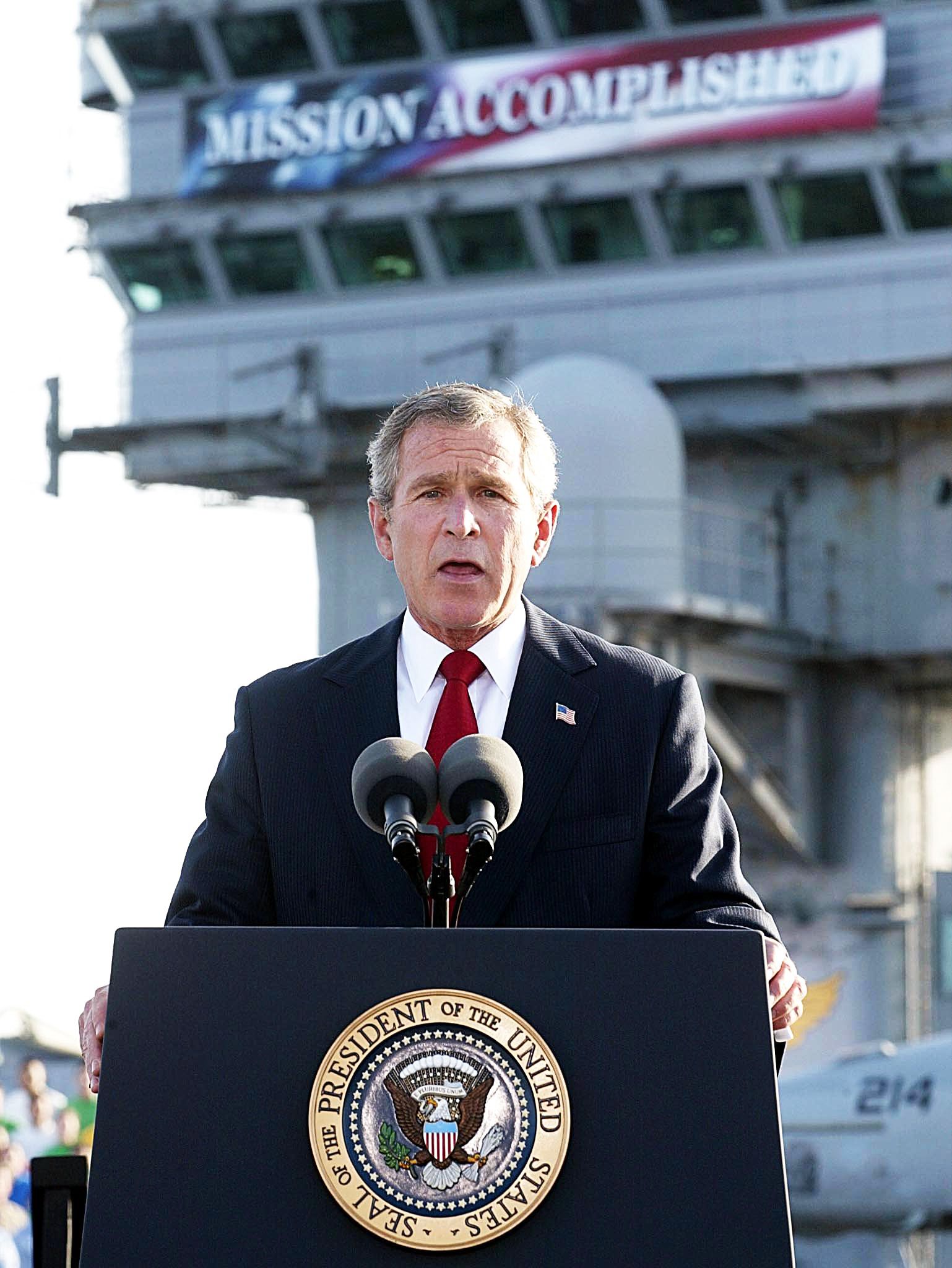
In a speech on board the nuclear aircraft carrier USS Abraham Lincoln on May 1, 2003, US President George W. Bush declares major fighting in Iraq has ended and celebrates “victory in a war on terror.” (AFP)
Operation Iraqi Freedom, the invasion of Iraq by a US-led coalition, began on March 20, 2003. Once again, following an aerial campaign of “shock and awe,” the Iraqi army collapsed in the face of superior firepower, but this would be no 100-day war. Chaos, civil war and insurrection would follow.
By the time US troops finally left Iraq in 2011, the conflict had lasted eight years and eight months and cost the lives of tens of thousands of Iraqi soldiers, insurgents and civilians, and 4,500 members of the US Armed Forces.
By comparison, looking back on the 30th anniversary of the end of hostilities in Iraq on Feb. 24, 1991, the First Gulf War seems almost like a more innocent time. As Prince Khaled pointed out, writing in 1993, the First Gulf War brought about positive changes in Gulf politics, especially in the nature of Arab-Western relations.
“Because of the history of these relations, the Arab instinct was to keep the West at arm’s length, but the crisis changed that mindset, making ‘never the twain shall meet’ an outmoded concept,” he wrote.
“The twain did meet. In the Arabian desert, it was demonstrated that when their interests converge, East and West can stand and fight together.”
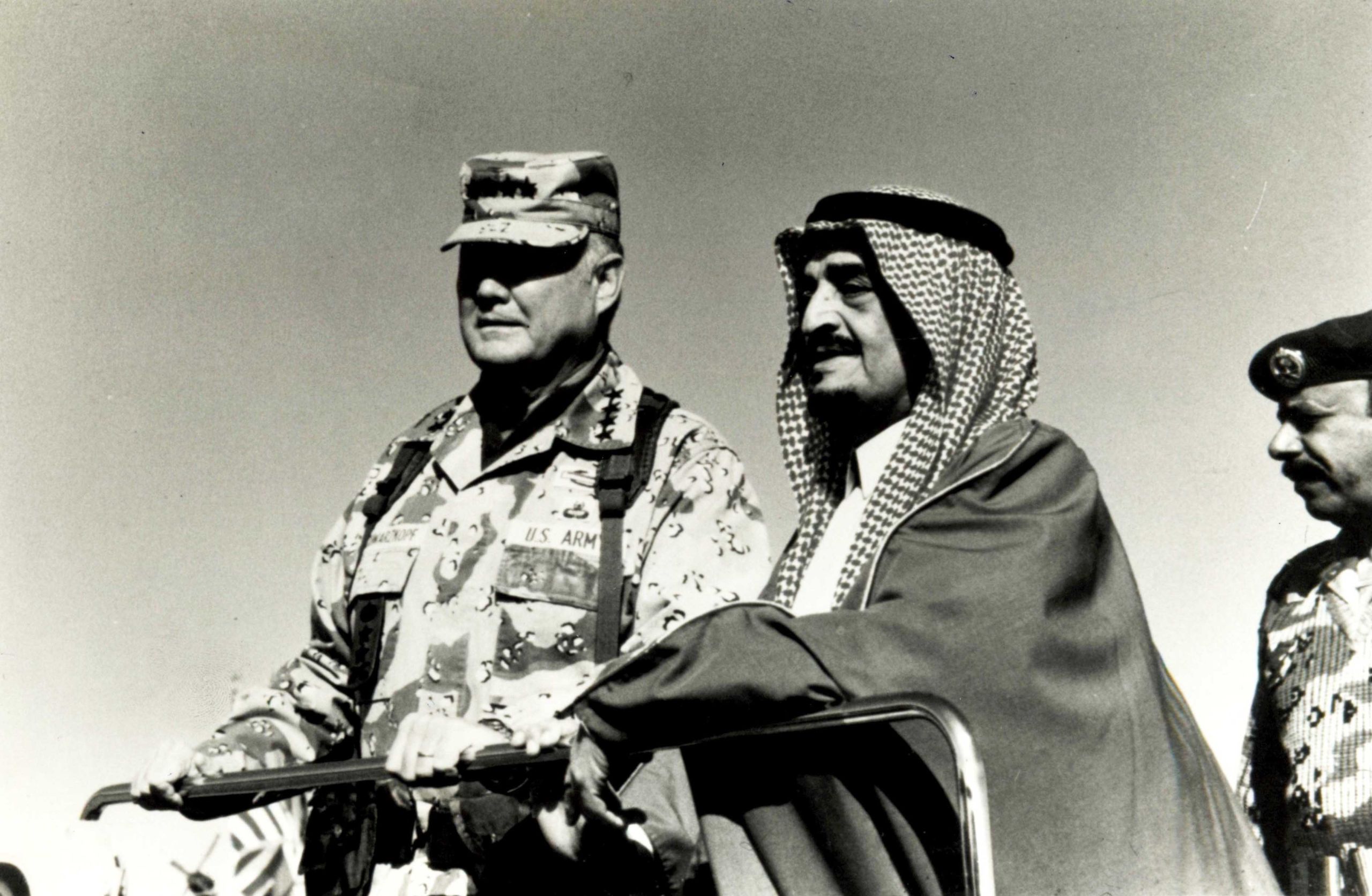
King Fahd with US Gen. Norman Schwarzkopf during the First Gulf War. “In the Arabian desert,” as Saudi Gen. Prince Khaled said, “it was demonstrated that when their interests converge, East and West can stand and fight together.” (SRMG Archive)
Saddam Hussein, captured by the Americans in December 2003 and hanged three years later after being found guilty by an Iraqi court of crimes against humanity, would pay the ultimate price for the outrages he perpetrated on his fellow Arabs in 1990.
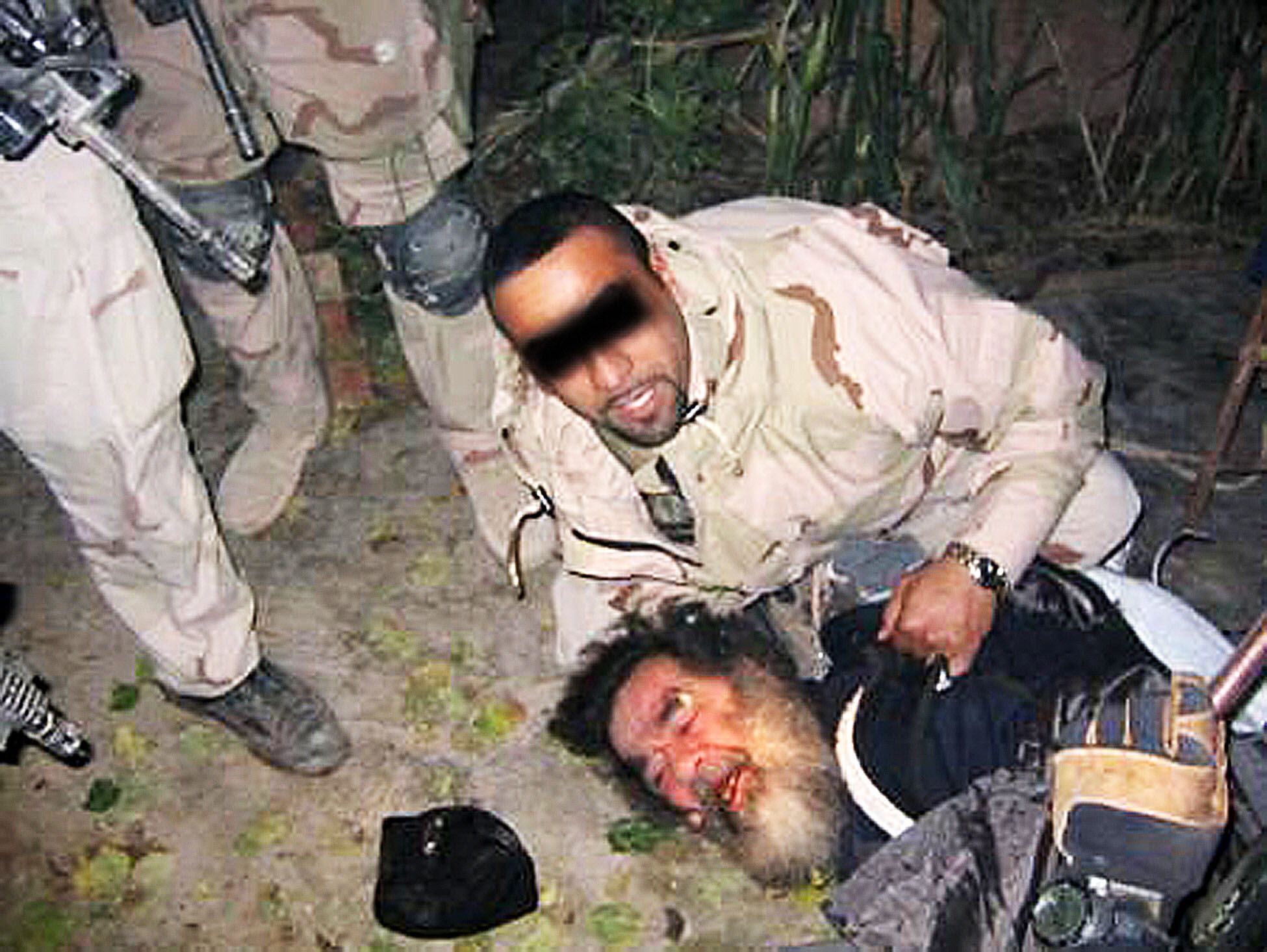
After months on the run, Saddam Hussein was captured by US troops on Dec. 13, 2003. He was found hiding in a hole in the ground near his hometown of Tikrit. (AFP)
But 30 years after the end of the war he inflicted on his own people and the wider Arab world, his legacy lives on, in the chaos and conflict that has gripped the region ever since.

The First Gulf War has been blamed for triggering a chain of catastrophies, including Al-Qaeda's attacks on America on Sept. 11, 2001. (Getty Images)
The First Gulf War has been blamed for triggering a chain of catastrophies, including Al-Qaeda's attacks on America on Sept. 11, 2001. (Getty Images)

In a speech on board the nuclear aircraft carrier USS Abraham Lincoln on May 1, 2003, US President George W. Bush declares major fighting in Iraq has ended and celebrates “victory in a war on terror.” (AFP)
In a speech on board the nuclear aircraft carrier USS Abraham Lincoln on May 1, 2003, US President George W. Bush declares major fighting in Iraq has ended and celebrates “victory in a war on terror.” (AFP)

King Fahd with US Gen. Norman Schwarzkopf during the First Gulf War. “In the Arabian desert,” as Saudi Gen. Prince Khaled said, “it was demonstrated that when their interests converge, East and West can stand and fight together.” (SRMG Archive)
King Fahd with US Gen. Norman Schwarzkopf during the First Gulf War. “In the Arabian desert,” as Saudi Gen. Prince Khaled said, “it was demonstrated that when their interests converge, East and West can stand and fight together.” (SRMG Archive)

After months on the run, Saddam Hussein was captured by US troops on Dec. 13, 2003. He was found hiding in a hole in the ground near his hometown of Tikrit. (AFP)
After months on the run, Saddam Hussein was captured by US troops on Dec. 13, 2003. He was found hiding in a hole in the ground near his hometown of Tikrit. (AFP)
Credits
Writer: Jonathan Gornall
Editor: Mo Gannon
Creative director: Simon Khalil
Designer: Omar Nashashibi
Graphics: Waleed Rabin
Video producer: Mohammed Qenan
Video editors: Ali Noori
Research: Rawan Radwan
Picture researcher: Sheila Mayo
Copy editor: Sarah Mills
Social media: Jad Bitar, Kateryna Kadabashy
Producer: Arkan Aladnani
Editor-in-Chief: Faisal J. Abbas
